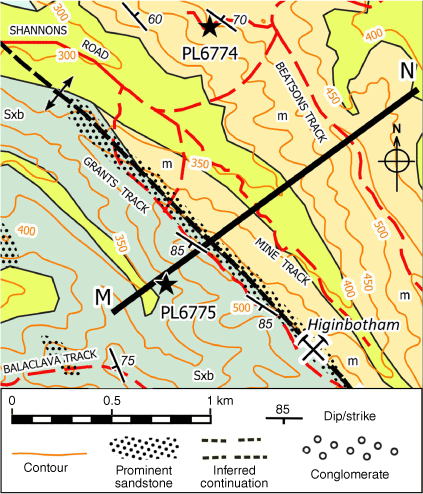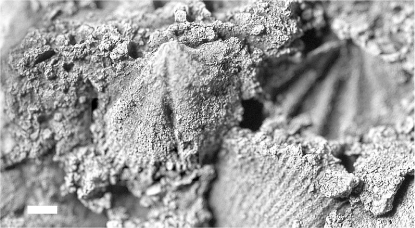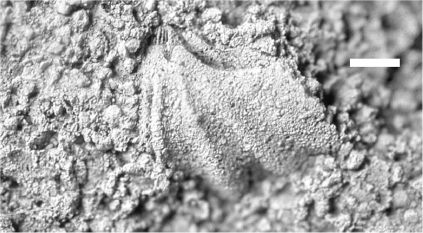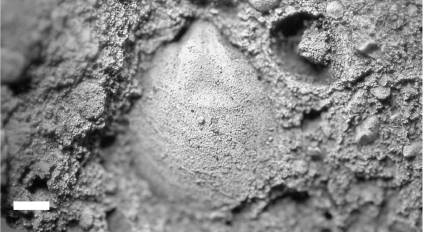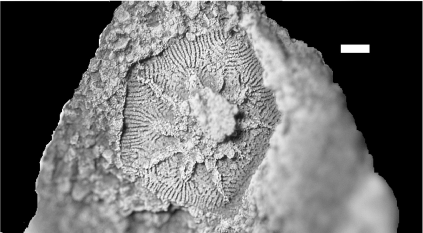Notanopliid brachiopods and associated fossils from the Yea area, central Victoria: a key to resolving age and correlation problems in a complex geological setting
Clem Earp A *
A *
A Independent Researcher.
Abstract
Poorly exposed and partly metamorphosed marine clastic sediments of the Broadford Formation and other units of Siluro-Devonian age occur in the Yea area of central Victoria, Australia. Numerous localities within the Yea area are reported in this study to contain brachiopod species in the family Notanopliidae, including Boucotia australis and Septaparmella plentiensis, and other associated fossils. A biostratigraphic scheme first proposed by M.J. Garratt and based mainly on notanopliids is widely used in central Victoria. Application of this scheme now results in confirmation of the age of the Broadford Formation in the Yea area as Pridoli–Lochkovian, with most of the unit being of Early Devonian age. This contrasts with earlier studies which claimed a late Silurian (?Wenlock–Pridoli) age based on reported occurrences of graptolites associated with the early Baragwanathia flora of the so-called Lower Plant Assemblage. It is concluded that at least some of the Lower Plant Assemblage localities are Early Devonian, but in other cases direct evidence from brachiopod biostratigraphy is lacking.
Keywords: Baragwanathia, biozones, brachiopods, Broadford Formation, Early Devonian, early land plants, late Silurian, Yea.
Introduction
Central Victoria contains a single fault-bounded structural zone, the Melbourne Zone (VandenBerg et al. 2000; Melbourne Trough of earlier authors; Melbourne Terrane of Talent et al. 2001, p. 149) (Fig. 1b). Limestones, and hence conodonts, are rare within the Melbourne Zone and are altogether absent from the Yea area, in spite of the toponym Limestone, which refers to Cenozoic calcrete. Late Silurian–Early Devonian graptolites are slightly more common, but are still rare in the Yea area and often poorly preserved.
(a) Location of southeastern Australia within the continent. (b) Southeastern Australia, location of the Melbourne Zone, and other areas (shown only symbolically) where notanopliids occur: Orange–Wellington region (Savage 1974; Talent et al. 2001, p. 155); Elmside Formation at Yass (Wright 1981; Talent et al. 2001, p. 159); Zeehan area (Gill 1950; Talent et al. 2001, p. 163); Scamander (Rickards and Banks 1979). (c) Central part of the Melbourne Zone showing location of the main Yea map (Fig. 2) and biostratigraphic localities outside the main Yea map but mentioned in the text.
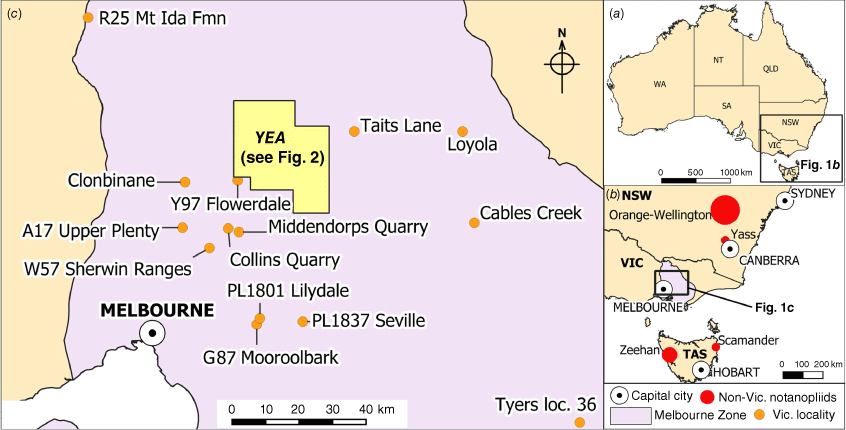
In many cases, dating in the Melbourne Zone relies on brachiopod assemblages in a biostratigraphic scheme proposed by Garratt (1983). The nominate species for most of these assemblages are notanopliids, which in Victoria are confined to the Melbourne Zone, although occur elsewhere in southeastern Australia (Fig. 1b, c).
Although these endemic brachiopod assemblage biozones are less precise than ones based on globally occurring graptolites or conodonts (Talent et al. 2000, p. 248), they remain the only practical means of estimating approximate dates for much of the Melbourne Zone. The identification of these biozones in the Yea area may be relevant to the age of the early land plant flora for which Yea is known internationally (Garratt and Rickards 1984).
The principal objective of this study was to obtain identifiable notanopliids and associated fossils from the Yea area, allowing a straightforward application of Garratt’s (1983) biostratigraphic scheme.
Excluded from the scope of this study is any detailed lithostratigraphic mapping of the Yea area. The general stratigraphy is described, some broad stratigraphic conclusions are reached, and maps and cross-sections are given but only for significant notanopliid localities.
The principal biostratigraphic conclusions reached are the following. The lowest shelly fossiliferous strata in the Yea area contain the Late Silurian notanopliid Septaparmella plentiensis (Garratt). The notanopliid Boucotia australis (Gill) sensu Garratt (1980a) has been found to occur at various widely separated localities in a sandstone member low in the Yea section of the Broadford Formation, indicating that the bulk of the formation at Yea is no older than Lochkovian. This is consistent with fossils from elsewhere in the Broadford Formation (Earp 2015).
Material and methods
This study was carried out intermittently over a number of years in the period 1994–2013 in parallel with similar studies elsewhere in central Victoria (see, e.g. Earp 2007, 2012, 2013, 2015). As this was private unfunded research, the resources available were limited and the consequent limitations on what could be achieved must be kept in mind.
As many exposures of bedrock were visited as possible, the most informative being the relatively fresh rock in road cuttings. On farmland (the majority of the Yea area) exposures are generally of limited extent and usually highly weathered. The method of ‘walking the outcrops’ was employed whenever possible, and it is believed that this has accurately discriminated marker units which had previously been either overlooked or conflated with others. As well as the collection of any fossils present, lithological observations and dip and strike measurements were taken when the quality of the exposure allowed.
Maps were drawn using QGIS version 3.18. Topography (roads, watercourses, contours) is taken without alteration (except where explicitly noted in Fig. 9) from Victoria State Government Department of Environment, Land, Water and Planning Data Services shapefiles. Geological mapping is based on Victoria State Government Department of Jobs, Precincts and Regions Earth Resources shapefiles generated as part of the Seamless Geology project (Morand 2010); alterations to those maps are discussed below. All shapefiles are used under Creative Commons public licenses. Cross-sections were generated by feeding QGIS contour intersection points into a Java cubic spline program which outputs Postscript drawing commands, and the resulting digital images were then manually coloured and annotated.
Photography was carried out using a variety of Nikon SLR equipment. At the start of the study this consisted of a Nikon FM camera (non-digital manual focus generally using black-and-white film) with extension tubes for closeups; by the end of the study the equipment was a Nikon D100 digital camera with Micro Nikkor autofocus lens for closeups. In most cases the specimens were whitened with ammonium chloride; where the matrix was itself white some specimens were painted with a blue dye ink before whitening (thanks to Des Strusz for this tip). As noted below, for one particular locality it was necessary first to remove thick amorphous ferric oxide by repeatedly soaking specimens in hydrochloric acid followed by rinsing and soaking in distilled water.
All fossil specimens and significant new localities described in this paper are registered with Museum Victoria (institutional acronym NMV), denoted by registration numbers beginning P and PL respectively. The abbreviation GSV refers to specimens or localities registered by the Geological Survey of Victoria. M or MUGD (Melbourne University Geology Department) specimen numbers cited by Philip (1962) and Garratt (1980a) are changed herein to the NMV P numbers which superseded them.
Previous studies
The geology (stratigraphy and palaeontology) of the Yea area was initially based on occurrences of fossils of the Baragwanathia flora. It was asserted that these fossils occur in two discrete horizons (Couper 1965; Garratt 1978) associated with two conglomerate or sandstone members, and dated by graptolites.
In all, more than a dozen published studies bear on this matter: Williams (1964), Couper (1965), Garratt (1977, 1978, 1980a, 1981, 1983, 1986), Garratt et al. (1983, 1984), Garratt and Rickards (1984, 1987), Rickards and Garratt (1990), Rickards (2000); not to mention unpublished theses: Garratt (1980b), Tims (1980).
However, those studies were based on faulty methodologies. In stratigraphy, the methodology pre-dated, or else took little notice of, seminal work in turbidite sedimentology such as that of Bouma (1962) and later workers. In palaeontology, the methodology used by graptolite experts in general, and well exemplified in the Yea papers of Garratt and Rickards (1984, 1987), Rickards and Garratt (1990), Rickards (2000), is too subjective and hence scientifically flawed.
The cited studies rely heavily on sketch maps, diagrams and line drawings. Since the proverbial dictum is that a picture is worth a thousand words, a detailed critique of those many studies would require a paper an order of magnitude larger than the present work, or indeed of usual journal page limits. That critique has therefore been placed in an unpublished but freely available paper (Earp 2023) which should be consulted if details are required, but it is to be read with the understanding that it is not peer reviewed. Many of the same criticisms on stratigraphy and palaeontology can also be found in the unpublished thesis by McSweeney (2022, ch. 9).
Those conclusions from the earlier studies which are accepted here are as follows.
Concerning stratigraphy, Couper (1965) confirmed an earlier study (Harris and Thomas 1941) which identified Walhalla Group sediments (Pragian–Emsian) in the eastern half of the Yea area. Couper (1965) identified a major anticline running through the town of Yea, later named the Yea Anticline (Garratt 1977), containing potentially older sediments.
The stratigraphy proposed by these early studies has been revised by more recent work from the Geological Survey of Victoria (Edwards et al. 1997; Welch et al. 2011) and is now based on the Broadford Formation (definitely Pridoli–Lochkovian, possibly extending upwards to early Pragian and possibly downwards to Ludlow) in the core of the Yea Anticline, and confirms the Walhalla Group (Pragian–Emsian) in the eastern area of Yea.
Concerning palaeontology, Couper (1965) listed notanopliid brachiopods (collected by Harris and Thomas 1941) of the Boucotia loyolensis biozone in the Walhalla Group at Killingworth.
Garratt (1978) and Garratt and Rickards (1984) proposed graptolite identifications from two localities which to them indicated a Gorstian (early Ludlow, Late Silurian) age for the sediments in the core of the Yea Anticline. Garratt and Rickards (1987; Rickards and Garratt 1990) also identified Pridoli graptolites from nearby localities, which to them confirmed the likelihood of the Ludlow age of the others.
Their identification of monograptids is here considered unreliable because of the subjectivity of the identification methods used, and there appear to be distinct morphological differences between their specimens and the taxa identified, even on their own data. The informal paper (Earp 2023) should be consulted for details of the issues involved.
However, their identification of Bohemograptus bohemicus, a Gorstian species, at a single locality is a different matter. The specimens are correctly identified, but they were not found in place, the site is used for stockpiling roadmaking material, and apparently no further specimens were found, so there remains a suspicion that they may not occur there naturally. A record of the Lochkovian bivalve Neklania at that locality (Garratt 1978) also does not by itself support a Silurian age.
Recent papers on Yea palaeobotany, in which M.J. Garratt was involved with the field work, have tended to question the Silurian age. McSweeney et al. (2021, p. 195) stated ‘a Lower Devonian age will be used when assigning an age to specimens at Yea’. McSweeney et al. (2022) explicitly re-assessed one of Garratt’s (1978) Lower Plant Assemblage sites as belonging to the Norton Gully Sandstone (Pragian–Emsian).
Lithostratigraphy
A barrier to correlation of the Yea area with other parts of Victoria has been the use of poorly defined local stratigraphic units such as the Yea Formation (Garratt 1977). The Seamless Geology Project (Morand 2010) and corresponding maps more recently issued by the Geological Survey (Welch et al. 2011) provide a firm basis for correlation for the first time, replacing the Yea Formation with the more widely recognised Broadford Formation (Edwards et al. 1997) on lithological grounds.
The stratigraphy in Welch et al. (2011) is an improvement on all previous attempts and is the basis of the maps in this paper. Figs 2 and 3 contain adjustments to match more closely the lithology observed.
Geological map of Yea and surrounding areas where notanopliids occur, with principal roads and rivers, based primarily on Welch et al. (2011, Map 33) with alterations suggested by this study. The smaller areas of the Yea district in Figs 3 and 9 in which this study concentrates is shown. The extent of the sketch map of Garratt (1978), much used in previous studies of the Yea area (Garratt et al. 1983; Garratt and Rickards 1984; Garratt 1986; Rickards and Garratt 1990), is also shown. To reduce clutter, labels for features (localities, etc.) shown in smaller scale maps are deferred to those maps. The abbreviation ‘H&T’ on some localities refers to Harris and Thomas (1941). Legend applies also to all subsequent maps.

Geology of the area within approximately 6–7 km centred on the town of Yea containing the principal notanopliid and other fossil localities and showing the location of smaller scale maps in Figs 10 and 11. The courses of two sandstone members of the Broadford Formation are shown only symbolically at this scale. In this and the other maps, no attempt has been made to infer the position of faults, and only the principal folds are shown. The area of Walhalla Group on the eastern part of this map, in particular, contains a large number of minor folds visible in road cuttings along Killingworth Road but it is not justified to infer that these extend southward in the manner shown by Couper (1965).
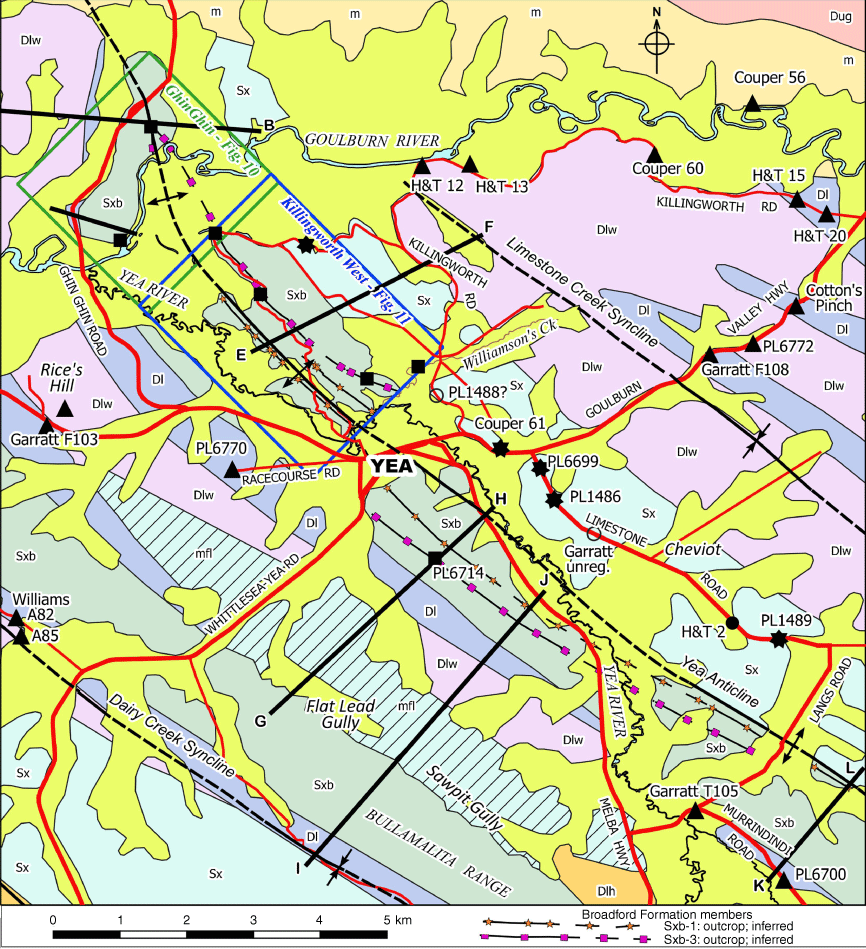
The major difference between the maps in this paper and the Yea mapsheet of Welch et al. (2011) is an explicit recognition of uncertainty caused by a number of factors. The Broadford Formation and Walhalla Group have very similar lithologies: turbiditic sandstone and conglomerate sequences separated by intervals of shale. Both units contain Boucotia australis, and are apparently only differentiated by Plectodonta bipartita and Lissatrypa lenticulata in the former, and Boucotia loyolensis in the latter, but those characteristic fossils are comparatively uncommon. Combined with the paucity of fossiliferous exposures, metamorphism, and the high degree of weathering, this frequently introduces an uncertainty in assigning outcrops to one unit or the other. Consequently, Figs 2 and 3 show portions of the Yea area assigned to indefinite geological units, rather than giving a potentially misleading impression to those who may be unfamiliar with the area.
In agreement with Edwards et al. (1997), the Killingworth Formation (Garratt 1977, 1978) in the Yea area is regarded as a junior synonym of the Norton Gully Sandstone (VandenBerg 1975), and the Humevale Siltstone is preferred over the Humevale Formation (Williams 1964, both units).
The use of the unit name ‘Flowerdale Member’ (Williams 1964) or ‘Flowerdale Sandstone Member’ (Garratt 1977, 1978) in the Yea area is rejected. Outcrops that might formerly have been assigned to this unit are regarded as discrete turbidite packages within either the Norton Gully Sandstone (Edwards et al. 1997, p. 45) or the Broadford Formation. The type locality of the member (loc. Y97, Flowerdale) is outside the Yea area and has palaeontology typical of the Broadford Formation (Earp 2015). Its correlation with the Yea area is uncertain (Sandford 2002).
The use of the unit name ‘Rice’s Hill Conglomerate’ (Couper 1963) or ‘Rice’s Hill Sandstone Member’ (Garratt 1977, 1978) is rejected. Field work does not demonstrate that there is a single continuous unit connecting outcrops previously identified as this member, and the coincidence of outcrops of suitable lithology with the supposed extent of the unit (Garratt 1977, 1978, fig. 2) is found to be very low. See also the comments made below relating to loc. PL6704.
It is not the case that outcrops assigned to one or other of those rejected units stand out from a fine-grained background. There are many coarse-grained turbidite packages in the area but their presence was ignored because of an outdated sedimentological methodology (Earp 2023).
Broadford Formation (Sxb)
The formation contains two facies types: massive sandstones associated with conglomerates, and interbedded turbidites (Edwards et al. 1997, p. 26), both observed in the Yea area. This suggests the environment was a submarine fan (Mutti and Ricci Lucchi 1972) with deposition from ‘distal turbidites’ (Stow and Shanmugam 1980) and/or hypopycnal plumes (Mutti 2019).
The Puckapunyal Formation was said to overlie the Broadford Formation (Edwards et al. 1997, p. 33) and differ from it only in being finer grained, lacking conglomerates. The Broadford Formation at Yea also shows a fining upwards; consequently the Broadford Formation here is considered to include the Puckapunyal Formation.
The boundary between the Broadford Formation and overlying Walhalla Group lies somewhere east of McLeish Road and west of Killingworth Road, but owing to a lack of identifiable fossils in this poorly exposed area, and the similarity of lithologies, the units cannot be separated. The boundary is far from clear, and this uncertainty is reflected in Fig. 3, cross-section EF in Figs 4 and 11.
Cross-sections at various points along the course of the Yea Anticline, to provide a smaller-scale geological context for the notanopliid occurrences. For the locations of these cross-sections, see Figs 2, 3, 9, 10.
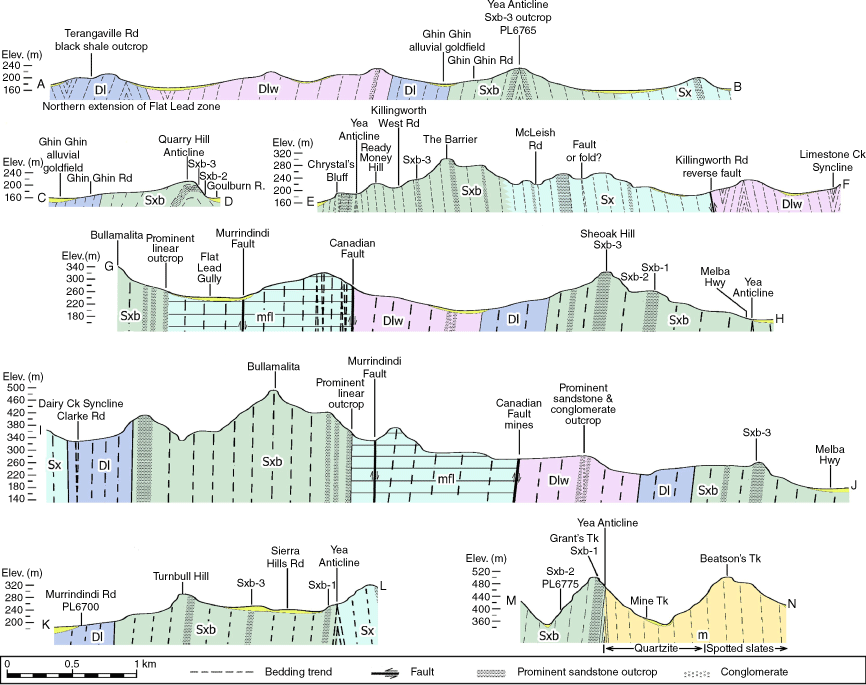
The lowest Broadford Formation in the Yea area is very poorly exposed siltstone below the first entry of thick sandstone of the Providence Hill (Sxb-1) Member. That siltstone is of a similar lithology to the overlying Ready Money Siltstone Member (Sxb-2) and the Humevale Siltstone and is nowhere well exposed. Some fresh material was excavated along the Melba Highway during construction of the North‒South Pipeline in 2009. It is also poorly exposed in a road gutter on the eastern and northeastern sides of Providence Hill.
The Broadford Formation in the Yea area fines to the south and east, and in this direction along the axis of the Yea Anticline it grades laterally into Humevale Siltstone. This important transition can only be observed in the forested Black Range area east and south of Murrindindi, which has seldom been the subject of field studies. In the Switzerland Ranges to the north and west along the Yea Anticline, the stratigraphy is overlain and hidden by the Strathbogie Granite of approximately Frasnian age (Phillips et al. 2022).
The occurrence of Septaparmella in the lower parts of both the Broadford Formation and Humevale Siltstone, and the occurrence of the assemblage of Boucotia australis, Plectodonta bipartita and Lissatrypa lenticulata in the higher parts of both, confirm the lateral equivalence of the two formations (Earp 2015). The latter assemblage also occurs in the Stoddart Member of the Mt Ida Formation (Neil 1982, at loc. R25 of Holloway and Neil 1982), confirming another lateral equivalence previously suggested (Earp 2015).
Three marker units within the Broadford Formation at Yea are given member status as they are identifiable throughout much of the area (Fig. 3).
Providence Hill Sandstone Member (Sxb-1)
This sandstone member of the Broadford Formation is named after Providence Hill, a former gold-mining area 1 km northwest of Yea (McKnight et al. 1998; Earp 2013). The ‘unnamed sandstone member’ of Garratt (1977) sometimes follows this member and sometimes the higher Barrier Sandstone Member (Sxb-3).
Medium- to thick-bedded quartz arenite, massive or rarely laminated. Some conglomerates known from the Killingworth West area are presumed to be part of this member, although their relationships are not completely clear. The best is exposed at Chrystal’s Bluff (Prowse and Finlay 1988; Earp 2013, pp. 66–67; Fig. 4 cross-section EF, Fig. 5b) and consists of a lensoidal mass of unfossiliferous open-framework conglomerate of slightly to well-rounded boulders of sedimentary rock within a muddy and sandy matrix.
Providence Hill Sandstone Member (Sxb-1) of the Broadford Formation. (a) Open cut at Providence Mine, Killingworth West, showing thick massive sandstone beds. (b) Conglomerate at Chrystal’s Bluff, Killingworth West. (c) Yea Anticline in shaft of the Higinbotham Mine, Murrindindi. (d) Quartzite outcrop with extensional quartz veining, on the east limb of the Yea Anticline at the Higinbotham Mine. a–c adapted from Earp (2013).
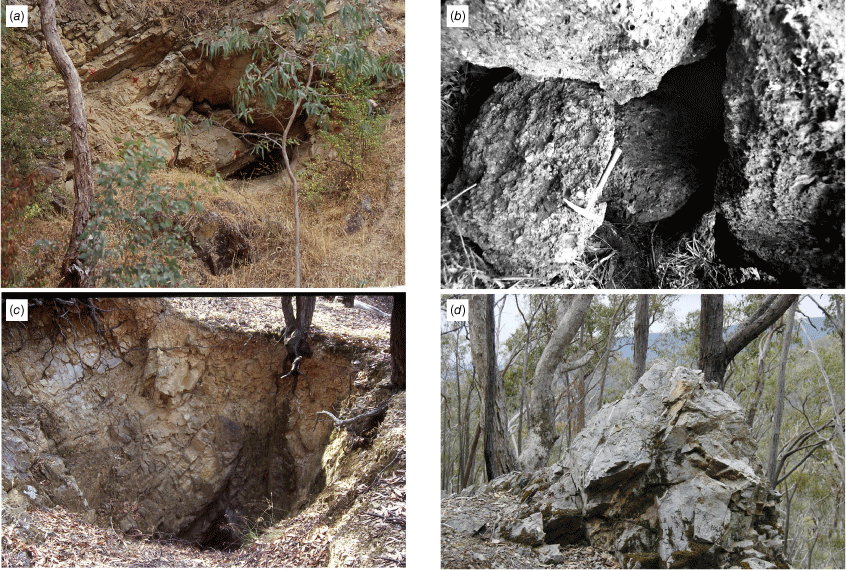
Well exposed in open cuts on Providence Hill (Fig. 5a); however, this section contains a number of close folds and brecciated faults (Stirling 1895b).
The lower boundary is marked by the sudden conformable transition from siltstone to massive sandstone. The upper boundary is poorly exposed in the north of the Yea area; in the Murrindindi area natural exposures show a similarly sudden transition from sandstone back to siltstone. The member is the most persistent of the Yea sandstone marker units, being identifiable as far south as the Golden Crown mine at Murrindindi (Earp 2013) where higher sandstones have completely disappeared.
Unidentified shelly fragments have been found at a number of localities including Providence Hill (PL6713). Float which may originate from high in this member contains Septaparmella plentiensis (Garratt) demonstrating an age no younger than earliest Lochkovian, more likely Pridoli, although a Ludlow age cannot be excluded.
Ready Money Siltstone Member (Sxb-2)
This siltstone member of the Broadford Formation is named after Ready Money Hill, a former gold-mining area 3 km northwest of Yea (Earp 2013, pp. 65–66; Fig. 11).
Effectively it is the fine-grained interval between Sxb-1 and Sxb-3. Thin- or medium-bedded siltstone (Fig. 6), or alternating thin-bedded fine sandstone and siltstone (Stow fine-grained turbidite sequences: Stow and Shanmugam 1980).
Ready Money Siltstone Member (Sxb-2) of the Broadford Formation. (a) Cross-section of the bedding in a slab of siltstone excavated by road works, Grant’s Track, Murrindindi. (b) Fossil locality NMV PL6775 showing typically poor outcrop of this member; M. Pepper for scale. One or two thin beds at the base of the outcrop contain lensoidal fossil breccia.

The unit is exposed on a farm track on the northeast side of Ready Money Hill and from there following Killingworth West Road to the poorly exposed contact with Sxb-3 at PL6705. The unit is most easily visible on the eastern slope of Sheoak Hill, south of Yea, where it can be seen in continuous superficial exposures from a low shoulder (where the contact with Sxb-1 is covered) up the side of the hill to the well-exposed contact with Sxb-3 almost at the ridgeline (Fig. 4, cross-section GH).
The boundary with the overlying Sxb-3 unit is marked by a sudden appearance of thick coarse graded sandstone turbidites. It is poorly exposed at Killingworth West (PL6705). The best exposures of the contact are at Sheoak Hill (PL6714) and Quarry Hill (PL6769; Earp 2007). In the Murrindindi area the unit is laterally continuous with the Humevale Siltstone to the south.
The member contains Septaparmella plentiensis (Garratt) indicating a minimum age of earliest Lochkovian, more likely Pridoli. Other brachiopods and a pleurodictiform coral were reported by Earp (2007), the latter similar to a long-ranging Pridoli–Pragian form (see under loc. PL6700 below). Calymenid trilobite fragments are common at loc. PL6775, and at loc. PL6774 the only fossil found was a complete phacopid trilobite (NMV P314413: Lochkovella ex gr. deckeri, D. Holloway pers. comm.), similar to specimens from the Pridoli or early Lochkovian Humevale Siltstone at Christmas Hills (Jell and Holloway 1983, as Reedops), and thus probably also from the plentiensis biozone.
Barrier Sandstone Member (Sxb-3)
This sandstone member is named after The Barrier, the prominent hogback ridge north of Yea township (some modern topographic maps erroneously assign this name to the stream referred to herein as Williamson’s Creek). The unnamed sandstone member of Garratt (1977) sometimes follows this member and sometimes the Providence Hill Sandstone Member.
Graded sandstone turbidites, often containing complete Bouma Ta–e sequences fining up to claystone intervals. Unlike the Providence Hill Sandstone Member, the Barrier Sandstone Member commonly contains lithic fragments and mica as well as the predominant quartz grains. The basal bed (Fig. 7) of the unit is gritty and usually contains fossil fragments; at Quarry Hill (PL6769; Earp 2007) these are quite large. An impersistent diamictite near PL6705 (Fig. 7c) contains well-rounded cobbles of green quartzite and smaller pebbles of white quartz. Sandstone beds may vary in thickness considerably along strike (Fig. 7d); the basal bed is 1.75 m thick at PL6705 but 6 m thick 250 m further south.
Barrier Sandstone Member (Sxb-3) of the Broadford Formation at fossil locality NMV PL6705, Killingworth West. (a) Symbolic stratigraphic diagram of the lowest 35 m, the beds classified by Bouma facies. (b) Lowest bed of the member, containing Boucotia australis right at the base. (c) Diamictite about 4.5 m thick centred on the 30 m level. (d) Sandstone beds at about the 33–35 m level showing lensing, maximum thickness just over 1 m.
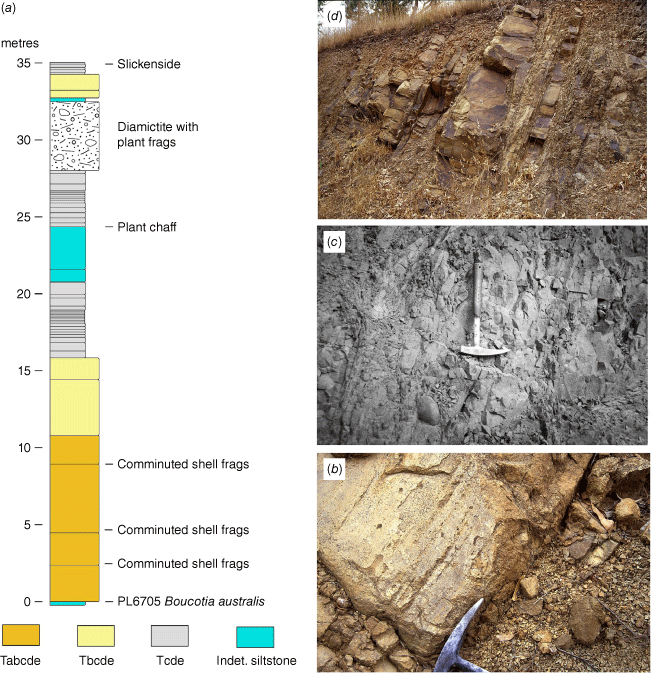
From PL6705 eastwards along Killingworth West Road until the lithology changes from predominantly sandstone turbidites (Bouma sequences) to predominantly thin-bedded siltstone shale (Stow turbidite sequences).
The upper boundary is clearest in the Killingworth West area, where thick turbidites are gradually replaced by thinner Stow sequences of alternating fine sandstone and siltstone. South of the Yea River, the upper boundary becomes obscure, sandstones thin out and the whole unit grades first into predominant siltstone with occasional turbidites, then entirely into siltstone continuous with the Humevale Siltstone.
The basal bed contains Boucotia australis, indicating an age above the base of the Lochkovian. Another characteristic fossil is a distinctive crinoid columnal Decacrinus sp. similar to that figured by Jell (1999, fig. 85) from a sandstone member in the Lochkovian levels of the Humevale Siltstone. Other brachiopods and a fragmentary pleurodictiform coral were reported by Earp (2007).
Humevale Siltstone (Dlh)
The typical Humevale Siltstone lithology of thick bioturbated siltstone (Williams 1964; Edwards et al. 1997, pp. 22–26) occurs with certainty along two structures in the study area: the Yea Spur Anticline and the Sheehan Hills Anticline (Fig. 8).
Humevale Siltstone (Dlh). Weathered bioturbated siltstone at the axis of the Sheehan Hills Anticline in a cutting near the highest point of Murrindindi Road. This was as it appeared in 2005; the outcrop has since been cut back by roadwork.

At the former, the siltstone overlies (or includes?) thick fine- to medium-grained sandstones; these may possibly correspond to one of the sandstone members seen in the Merriang Syncline further west, e.g. the Mt Phillipa Member, or the Clonbinane Sandstone (as suggested by Garratt 1977), but because the Yea Spur sandstones have so far proved unfossiliferous, evidence is lacking.
At the Sheehan Hills, the fold is not deep enough to expose the sandstones. The Humevale Siltstone here was mapped by Garratt (1977, 1978) as Yea Formation, but its bioturbated siltstone lithology is unlike that at other supposed locations of his Yea Formation.
As mentioned above, in the heavily forested (and metamorphosed) area south and east of Murrindindi, sandstones in the Broadford Formation fade out and only poorly exposed metamorphosed siltstone remains, assumed here to be the Humevale Siltstone.
In the Yea Spur – Junction Hill area the siltstone underlies a turbidite package which has been taken as belonging to the Broadford Formation (Earp 2015). Exposures are very poor in the Sheehan Hills area, but a similar sequence is present.
The base of the Humevale Siltstone elsewhere in central Victoria is undoubtedly of Ludlow age based on graptolites such as Bohemograptus bohemicus (Garratt 1983; Rickards and Sandford 1998). The bulk of the formation may be Lochkovian because of the common occurrence of Boucotia species (Garratt 1983; Jell 1992; Earp 2015). The top of the formation may range into the Pragian based on trilobites (Sandford 2004); in this context, the reported possible identification of Uncinatograptus thomasi in the Yea Spur – Junction Hill area (Rickards in Sandford 2002) is understandable; this area contains a number of parallel strike ridges and an imbricated sequence is possible.
Indeterminate (Sx)
Bordering areas of certain Broadford Formation are poorly exposed areas of interbedded shales and turbidites without identifiable fossils. As noted previously, the lithological similarity of short subsequences of the Broadford Formation and overlying units make a determination of the boundary uncertain. These areas are therefore assigned to this informal unit, and the boundary is shown in the cross-sections as indeterminate. These areas also contain indications of stratigraphic discontinuities. For example, on Killingworth West Road about 650 m due east of PL6715, strata poorly exposed in the road surface show a small but definite sudden change in the predominant strike; but whether this is due to a fault or folding cannot be determined from the weathered and very poor outcrop. Another such change of strike may lie underneath the north end of McLeish Road.
Transitional (Dl)
Essentially this is the combined Wilson Creek Shale ‒ Easts Lookout Siltstone unit of Welch et al. (2011, as ‘Dne-Sji’). This informal unit may include a number of shaly, sometimes anoxic formations of late Lochkovian to ?Emsian age which are poorly exposed and mostly faulted out. It occurs roughly along the axis of Murrindindi Road and may include one or more of the Wilson Creek Shale, Woori Yallock Formation (Morand 2010; formerly Yeringberg Formation), and a basal shale member of the lower Walhalla Group (designated the Easts Lookout Siltstone in the Eildon area). Fossils are reported below (under loc. PL6700).
The unit includes a small number of anoxic shale occurrences in the Yea area (e.g. Fig. 4 cross-section AB), which are unfossiliferous and with poor stratigraphic context, and are therefore not definitively assigned here to the Wilson Creek Shale as was common in the past (Garratt 1980b; Edwards et al. 1997).
Walhalla Group (Dlw)
No separation will be made in this paper between units in this group, viz the basal shale member (designated Easts Lookout Siltstone at Eildon), Norton Gully Sandstone, and Monty’s Hut Formation (VandenBerg 1975; VandenBerg et al. 2006). Poor exposures, metamorphism and weathering obscure any certain means of determining the boundaries between these formations in the Yea area given the lithological similarity of short subsequences within the three units.
Certainly most, if not all, of the eastern half of the Yea area falls within the Walhalla Group (Couper 1965) based on the lithology of turbiditic sandstones interspersed with shales, and the palaeontology of Uncinatograptus thomasi, Boucotia loyolensis, and associated fossils, indicating a late Pragian to ?Emsian age.
Devonian intrusives
Late Devonian igneous intrusions near the contact with the Strathbogie Granite have been described by Phillips et al. (2002). Phillips et al. (2022) have mapped in great detail the boundary between the metasediments and the granite batholith and inferred that the Strathbogie Granite forms a tabular mass 400–500 m thick overlying the Siluro-Devonian.
A single 10 mm aplite sill was observed at Killingworth West, associated with quartz veining which was noted by Prowse and Finlay (1988).
There are a number of indications of intrusive activity around Yea township. A gold miner at Providence Hill stated that a cross-cutting fault breccia sometimes contained ‘spew of granite’ (J. Cook in Bell et al. 1891). At McKenzie’s Hill, immediately east of Yea, the highway cutting shows a large discoloured patch associated with quartz veining. Here, overlying shale (Couper 1965, loc. 61) shows spotted slate metamorphism and development of mica, suggesting a large subsurface intrusion. At loc. PL1486, Barkley’s Cutting, Limestone Road, there is a weathered igneous dyke about 0.5 m wide.
No intrusions near the Murrindindi Granodiorite have been noted in this study because of the very poor exposures in that area. Quartz veining and silicification are not unusual in outcrops on the former Murrindindi goldfield (Earp 2013).
Metamorphic
The Strathbogie and Murrindindi granites are surrounded by wide metamorphic aureoles. These range in grade from spotted slate to hornfels, and combined with weathering often make identification of the original sediments difficult. Phillips et al. (2022) have given estimates for the width of the Strathbogie aureoles at various metamorphic grades.
Quartzitic metamorphism is well developed near the Higinbotham Mine, Murrindindi, on the footwall (eastern limb) of the locally faulted Yea Anticline (Figs 4 cross-section MN, 5c, d).
Somewhat different is the pressure metamorphism found in the Flat Lead area southwest of Yea township (Fig. 4 cross-sections GH, IJ). Here the sediments are metamorphosed to foliated slate and in extreme cases to schist. The area contains several folds spaced metres to tens of metres apart. There is some evidence it is bounded on the east by a fault or shear running through the old Canadian, Halfway and Sunny Hills gold mines (Earp 2013, pp. 81–82). A major fault, the Murrindindi Fault of Garratt (1977), has been inferred on the western side. While there is some evidence for this fault in the Homewood area, its location on the topographic low along Flat Lead and Sawpit Gullies is uncertain. The lowest point on the wind gap separating these two gullies is bare rock, and shows no signs of any fault.
Biostratigraphy
The number of identifiable brachiopod species obtained from Yea localities is relatively small compared to the rich assemblages recorded from, for example, Lilydale. Notanopliid species allow at least some estimate of the brachiopod assemblage biozones.
Septaparmella plentiensis biozone
The type locality of the nominate species is in the Humevale Siltstone (Garratt 1980a). No identifiable specimens have been obtained from the Humevale Siltstone in the Yea area, but the lowest members of the Broadford Formation contain the species. This is sufficient to identify this biozone with some certainty, even though Garratt (1980b, fig. 67, 1983, fig. 6) admitted some overlap of Septaparmella into the younger Boucotia janaea biozone.
This is in forest to the west of Grant’s Track, Murrindindi (Figs 4 cross-section MN, 6b, 9). The lithology and faunal assemblage have been described previously (Earp 2007). Septaparmella plentiensis occurs with other brachiopods and trilobites in rare lensoidal lag deposits within the Ready Money Siltstone Member. Near the ridgeline directly above the site, float of gritty sandstone, probably from the highest part of the Providence Hill Sandstone Member, contains specimens which seem to be the same species. Triseptate notanopliids have not been found at this locality.
Boucotia australis biozone
The B. australis biozone in the Yea area is considered for the purposes of this paper to include the B. janaea biozone.
The B. janaea biozone is not well characterised, as several species cross into the younger B. australis biozone, particularly Plectodonta bipartita, Maoristrophia keblei, Lissatrypa lenticulata and a small Howellella (Garratt 1980b, p. 84, 1983, fig. 5).
In addition, the coarse matrix of sandstones in the Broadford Formation makes it difficult to discriminate between the Boucotia species, which differ only in that the septa in the dorsal valve of B. janaea are furrowed while those in B. australis are not (Garratt 1980a, p. 33). Of the Boucotia dorsal valves figured in this paper, only NMV P321663 (Fig. 13e) might possibly be B. janaea, but the preservation is not good enough to be sure.
The B. australis biozone in the Yea area is recognised only in the Broadford Formation at the level of the Barrier Sandstone Member and above. Outside the Yea area, the biozone can be identified in the Humevale Siltstone (Garratt 1983), the closest locality being PL6809 (Fig. 2; Earp 2015).
This is probably the fossil locality reported by Stirling (1895a) on the Ghin Ghin goldfield. Small natural outcrops of coarse fossiliferous sandstone represent the Barrier Sandstone Member and have yielded a few notanopliids here identified as Boucotia cf. australis although the septa in the pedicle valves lack modified crests. It is assumed that the coarse matrix has caused them to appear unmodified; the alternative explanation would be that they are Notanoplia pherista, an identification which would not alter the assignment to the B. australis biozone.
This is the basal bed of the Barrier Sandstone Member exposed where the Goulburn River has eroded away the east side of a dome-like structure (the Quarry Hill Anticline, Prowse and Finlay 1988; Figs 4 cross-section CD, 10). The lithology and faunal assemblage have been described previously (Earp 2007). As well as Boucotia australis and Notanoplia philipi, there are larger brachiopod fragments including Maoristrophia keblei and Mesoleptostrophia affinalata. These support an assignment to the B. australis rather than B. janaea biozone.
Geology of the area about the site of the now vanished gold-mining town of Ghin Ghin (Earp 2013, pp. 46–51) showing the connection with the Killingworth West area to the south. A number of small faults inferred by Whitelaw (1899) and Prowse and Finlay (1988) are not shown. The axis of the Quarry Hill Anticline was temporarily exposed by building works in October 2004 and showed a smoothly rounded fold in sandstone with none of the jointing seen in the chevron-shaped Yea Anticline. Contours at 20 m intervals.
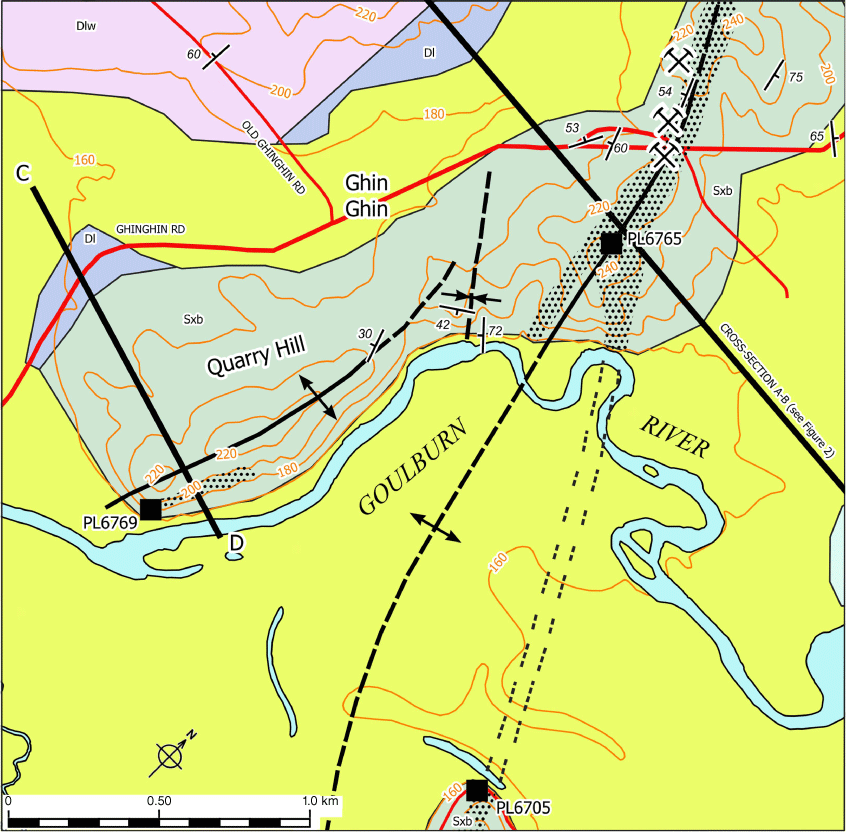
This is loc. F102 of Garratt (1983, fig. 4) at Killingworth West (Figs 7, 11). Boucotia australis is found in the coarsest fraction of the basal bed of the Barrier Sandstone Member along with a small Howellella, Lissatrypa cf. lenticulata, tabulate coral fragments, Decacrinus columnals and other unidentifiable calcareous remains. Many of the fossils are obscured by masses of amorphous ferric oxide; some Boucotia specimens resembled Septaparmella until the oxide was removed with hydrochloric acid. Plant chaff occurs some 23 m above this, and there are also plant fragments in a diamictite bed a further 5 m above that. The locality was also numbered KW1 by McSweeney (2022, ch. 9) who stated that it was an unpublished B. australis locality of G.E. Williams. Specimens illustrated by McSweeney (2022, ch. 9, Fig. 5) are the small Howellella and an oxide-coated B. australis ventral valve misidentified as Septaparmella.
Geology of the Killingworth West area, centred about The Barrier, the hogback ridge to the north of Yea township. Locality marked ‘Dec’ contains Decacrinus. The strike of the strata is sometimes at a slight angle to the topography, perhaps indicating erosion along jointing induced by folding later than that which produced the Yea Anticline (Noel Schleiger, pers. comm. 2000). As shown, both the strike and the topography deviate towards the east as they approach the Yea River, where there is a marked discontinuity along the eastern side of the ridge, and the predominantly thin-bedded siltstone lithology exposed in Williamson’s Creek cannot be correlated with anything to the north. Contours at 20 m intervals.
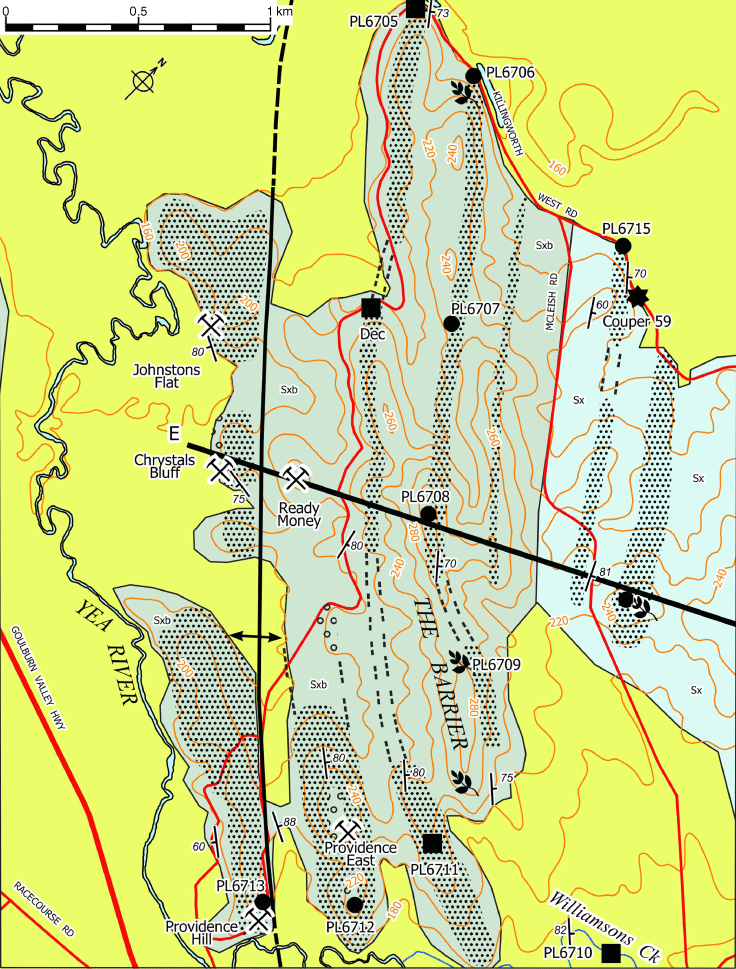
A thin coquinal layer, probably a lag, in a sandstone outcrop forming a natural bar in the watercourse here named Williamson’s Creek (Figs 3, 11). The observed assemblage is very similar to that at loc. PL6705 with Boucotia australis, Decacrinus and the small Howellella. Ferric oxide deposits are not present, and the specimens are some of the cleanest found in the Yea area. The lithology of this bed and the surrounding thin-bedded siltstones cannot be matched with anything along the apparent direction of strike, evidently a sign of the structural complexity along the line where the Yea River executes two successive right-angle turns.
Note that by simple extrapolations of strike, locality PL6710 should be stratigraphically below PL1488, at which Garratt (1978) reported Silurian ?Saetograptus sp., and also below PL1486 from which Silurian Bohemograptus bohemicus has been reported (Garratt 1978; Garratt and Rickards 1984). Either such extrapolations over unexposed ground in this area are unreliable, or there is something wrong with the reported graptolite palaeontology, or both; but this illustrates the need for caution when accepting major palaeontological claims based on no other evidence than a sketch map.
The same basal bed of the Barrier Sandstone Member as at PL6705 outcrops near the top of Sheoak Hill. Iron oxide is not such a problem as at PL6705, and Boucotia australis was readily recognised not only in collections made during the field work, but also in slabs at Museum Victoria (collector unknown, early twentieth century) labelled as coming from this hill (one of these also contains a Mesoleptostrophia valve labelled ‘perforated plate’). In addition, a number of specimens of Plectodonta bipartita were also obtained.
Boucotia loyolensis biozone
In the Yea area this biozone was identified by Garratt (1983) from occurrences of the nominate species first noted by Couper (1965). At Yea the species is confined to the Walhalla Group, but in its absence the biozone can also be identified in the underlying transitional unit at loc. PL6700 by a number of fossils in common with the Woori Yallock Formation (see below).
The graptolite biozone of Uncinatograptus thomasi is considered here to be coeval with a lower part of the B. loyolensis biozone. This graptolite species occurs in the Walhalla Group in the Yea area (Garratt 1983) and to the northwest along the general direction of strike at loc. F16 of Schleiger (1964) (see Fig. 2). From the latter locality, Jaeger (1983, p. 253, as ‘Freeman’s Gully’) reported U. thomasi alexandraensis.
The locality is shown on a map in Harris and Thomas (1941) but Couper (1963) could not match the lithology with any current exposure and suggested it had been removed by road works. The numerous fossil specimens (including B. australis and B. loyolensis) collected by the Harris and Thomas party and listed in Couper (1965) are now in Museums Victoria and identifications were confirmed in this study.
Thick-bedded sandstone and diamictite with lensoidal deposits of poorly preserved shelly fossils, another facies common in the Norton Gully Sandstone. Couper (1963) recorded a Howellella sp. (omitted from the table in Couper 1965) and Garratt (1983, as loc. F100) recorded ‘Nowakia acuaria’. In this study, a single specimen of Boucotia loyolensis was obtained.
The dacryoconarids recorded by Garratt could not be located in Museums Victoria and the identification should be treated with caution. Almost all Victorian ringed dacryoconarids were erroneously conflated with this species by Bouček (1964), leading to considerable biostratigraphic confusion. No Victorian dacryoconarid identifications prior to the beginning of work by Alberti (1988) should be regarded as certain.
The statement by Couper (1965, p. 7) that at this locality ‘the plant horizon succeeds a fossiliferous granule conglomerate-medium sandstone horizon’ would appear to be based on inference rather than direct observation. The outcrop ends abruptly where a small cliff drops away, and no plant fossils were recorded (Couper 1963, 1965). The statement may be based on extrapolation from other localities in the same general area. The very thick beds observed at loc. 60 are not repeated on the other limb of the adjacent anticline, an indication that once again such extrapolations are not reliable.
A single specimen of Boucotia australis has been obtained from a Ta turbidite bed at this faulted cutting just west of Cotton’s Pinch. The lithology of highly weathered interbedded sandstone and shale indicates Norton Gully Sandstone, and thus the B. loyolensis rather than B. australis biozone. No other fossils can be identified among the comminuted fragments.
A bed of silicified sandstone exposed on the road leading to a cellphone tower on Rice’s Hill contains rare isolated disarticulated valves, including Boucotia australis (single ventral valve only), a large Howellella and a reticularioid. No more than 4 m stratigraphically below this is loc. 64 of Couper (1965), presumed to be the pebbly conglomerate (containing unidentifiable shell fragments) poorly exposed on some parts of the hill. A complex structure involving faulting and folding was inferred by Prowse and Finlay (1988). Loc. F103 of Garratt (1983) is very thin-bedded shale in a cutting on the highway nearby and was assigned to the Norton Gully Sandstone (Walhalla Group), Pragian–Emsian (McSweeney et al. 2022, p. 45).
The pebble conglomerate at Rice’s Hill was one of only two noted at Yea by Couper (1965), the other being at his loc. 66, Dairy Creek Road (Williams 1964, loc. A85). These were considered to be of different ages, falling into the ‘Rice’s Hill Sandstone’ and ‘Flowerdale Member’ (sensu Couper 1965 and Garratt 1978) respectively. Loc. A85 is here assigned to the B. loyolensis biozone because of Walhalla Group fossils such as the bivalve Panenka at adjacent loc. A82 (Williams 1964; loc. 65 of Couper 1965). That is, the ‘Rice’s Hill Sandstone’ and ‘Flowerdale Member’ of the two sites are probably coeval if not identical.
This Murrindindi Road locality and its faunal assemblage have been briefly described in a previous paper (Earp 2007). The geological context is shown in Fig. 4 cross-section KL. The lithology is a mass-flow diamictite. Boucotia australis is common, to the extent that exhaustive illustration of the available specimens would be pointless. Other Early Devonian fossils include a nowakiid dacryoconarid; trilobites including Kettneraspis; brachiopods including Mesoleptostrophia affinalata, ‘Hysterolites’ lilydalensis, Plicocyrtina sp. and Tyersella typica; bivalves Praectenodonta raricostae and Cypricardinia crenistria; and a rostroconch. Trilobate ostracodes similar to ‘Beyrichia’ cf. wooriyallockensis also occur, but given the current taxonomic uncertainties surrounding these at Woori Yallock (see, e.g. Camilleri and Warne 2015), a definite identification is not possible.
‘Pleurodictyum megastoma’ reported by Earp (2007, fig. 2) is similar to a form designated as Ligulodictyum s.l. n. sp. I by Plusquellec (2015, p. 22, fig. 5D), ranging from Pridoli to Pragian and thus uninformative as to biozone.
The diamictite outcrops about 4.3 km further south at loc. PL6764 but there the fossils are less well preserved and only Cypricardinia could be identified with certainty.
Baragwanathia longifolia occurs in highly weathered spotted shale underlying the diamictite at PL6700. This sequence has some similarity to the Wilson Creek Shale overlain by richly fossiliferous Woori Yallock Formation at Seville, east of Melbourne.
Discussion: age of the Lower Plant Assemblage
The question to be addressed in this section is the age of the Lower Plant ‒ Graptolite Horizon (Couper 1965) or Lower Plant Assemblage (Garratt 1978) at Yea in light of the evidence from this study. The claimed Gorstian (early Ludlow) age is based on graptolites at two localities (Garratt and Rickards 1984), but eight other localities were mapped as belonging to the Lower Plant Assemblage (Garratt 1978). Since they have no record of graptolites at these other localities, that leaves lithostratigraphy as the remaining line of evidence put forward by Garratt et al. (1984). As noted above, the lithostratigraphy has been considerably revised by Welch et al. (2011), to the extent that even the two Gorstian graptolite localities now appear to be mapped in Early Devonian units.
The claim of a Gorstian age for the Yea Baragwanathia flora (Garratt 1978; Garratt and Rickards 1984; Garratt et al. 1984; Rickards 2000) has raised an issue with attempts at reconstructing the chronology of land plant evolution. The genus appears earlier in the fossil record than any comparable plant (Kenrick and Crane 1997, table 7.5). While phylogenetic studies continue to group Baragwanathia among the more advanced genera (Kenrick and Crane 1997, p. 177), this has been at the expense of ignoring or deprecating any evidence for a Silurian age (e.g. Kenrick and Crane 1997, p. 340).
If correct, a Silurian age for those particular Yea localities is therefore of no small importance to the timeline of the evolution of terrestrial life. However, past geological studies of the Yea area have been unsatisfactory as regards the standard of the evidence provided for such a significant claim. The problem is that the Siluro-Devonian clastic sediments of the Yea area of central Victoria are difficult to date.
While it is easy enough to use notanopliids to assign a biostratigraphic age to much of the Yea area in general, it is more difficult to assign such an age to any specific locality where notanopliids are not present.
There is usually a facies separation between the brachiopod fauna (generally in lags or sandstone Ta turbidite layers) and plant macrofossils (claystone shales); the two almost never co-exist. This is due to differing transport mechanisms which separate the fossils by flow and flotation properties. There is no known Lower Plant Assemblage locality which contains notanopliids, so no direct application is possible.
Correlation of Lower Plant Assemblage and notanopliid localities by extrapolation of the stratigraphy along strike is a possibility, but the poorly exposed nature of the Yea area masks structural complexity. Consequently, a plant macrofossil locality may be separated from the nearest brachiopod locality by an unexposed section of considerable extent both stratigraphically and laterally, such that a stratigraphic relationship between the two cannot be taken for granted based only on simply extrapolating or interpolating the strike. This was noted above, under loc. PL6710.
Another example of the same problem is the plant chaff at PL6705 (Fig. 7a). These are the plant fossils reported as ‘another floral horizon lacking Baragwanathia’ (Garratt 1981) and ‘fragments which might prove to be of vascular plant origin’ (Garratt et al. 1984, p. 358) said to occur 600 m (or 500 m respectively) below the Lower Plant Assemblage. The fossils are here dated by underlying B. australis to be no older than Lochkovian, and are therefore unremarkable in Victoria, as similar fragments have long been known from the australis biozone of the Humevale Siltstone, for example at Collins’ Quarry (Williams 1964) and Middendorp’s Quarry (Jell 1992). It cannot now be maintained both that the Lower Plant Assemblage is of Silurian age because of the lithostratigraphy, and that the ‘floral horizon’ at PL6705 is stratigraphically beneath it; at least one of these statements is incorrect.
Consequently, in this section only those Lower Plant Assemblage localities will be considered where notanopliids occur near enough that other evidence (primarily lithology) indicates an extrapolation along strike is plausible.
Couper (1965) listed eight localities in his Lower Plant–Graptolite Horizon. Of these, two are on the west limb of the Yea Anticline; the others are all on the east limb. The two on the west limb are loc. 64 (here: PL6704), which has been shown above to be Early Devonian, probably B. loyolensis biozone; and loc. 63. The latter, a Baragwanathia locality (here: PL6770), is on strike with and is lithologically similar to the locality F103 of McSweeney et al. (2022) and is likewise here assigned to the B. loyolensis biozone.
Garratt (1978) showed 10 Lower Plant Assemblage localities on his map, two of which are on the west limb of the Yea Anticline, and in addition there is a ‘Monograptus cf. uncinatus’ locality (implying a Ludlow age) which is also to the west of the anticline. The western localities are not labelled, but can be identified from other information (Earp 2023).
One is loc F103, that is, the locality of McSweeney et al. (2022) which they assigned to a unit in the B. loyolensis biozone. The other is loc. T105 (Garratt 1980b, 1983, Fig. 4), with indeterminate plant axes, which is close to, lithologically similar to, and on strike with PL6700, and is therefore also in the B. loyolensis biozone. The monograptid locality is loc. E56 (NMV PL1443), with the graptolite more recently being re-identified as ‘M. thomasi?’ (Rickards in Sandford 2002, p. 6) and again indicating the B. loyolensis biozone.
Consequently, all the Lower Plant Assemblage or Silurian localities west of the Yea Anticline shown in the maps of Garratt (1978) and Garratt and Rickards (1984) are now considered to be in the B. loyolensis biozone, and of Pragian–Emsian age rather than Silurian.
There remain the localities on the eastern side of the Yea Anticline. These include the two localities claimed to contain Gorstian graptolites: PL1486 Limestone Road (Garratt 1978, ‘Loc. 4’) and PL1487 Ghin Ghin (Garratt 1978, ‘Loc. 1’). Here there is a difficulty, in that notanopliid localities are not close enough to the plant and/or graptolite localities to allow any certain correlation over unexposed ground.
For example, in the Ghin Ghin area, B. australis biozone loc. PL6765 is almost exactly on the axis of the Yea Anticline, and therefore one might expect that the three Lower Plant Assemblage localities in that area, which are shown by Garratt (1978, fig. 2) to be on or slightly above the axis, and by Garratt and Rickards (1984, fig. 2) to be on or well above the axis, might also lie in the B. australis biozone. This is an inference which is not considered here to be warranted given the distance between these localities and PL6765; on the other hand the evidence is not supportive of a Ludlow age either.
In the Killingworth area, Lower Plant ‒ Graptolite loc. 59 of Couper (1965) seems well above the horizon of B. australis biozone loc. PL6705, but again there is too much unexposed interval between the two to infer with certainty that loc. 59 is in that biozone or higher. However, it should be noted that the lithology (coarse turbidites) around loc. 59 is more similar to that at PL6705, suggesting the same biozone, than to that at Ghin Ghin to the north or Limestone Road to the south, but again the question is here left open.
The other localities on the eastern side of the Yea Anticline have no nearby notanopliid localities, and therefore no inferences can be made from this study. For a detailed review of other evidence bearing on these localities, see McSweeney (2022, ch. 9) and Earp (2023).
It should be mentioned that during the course of this study, additional Baragwanathia specimens were recovered from eastern localities on Limestone Road, both at a new locality (PL6699, fig. 3) and a new record, at graptolite locality PL1489 (Rickards and Garratt 1990, loc. T2).
Systematic palaeontology
As the object of this study is mainly to record new occurrences of previously described species, this systematic section generally contains much reduced synonymies, descriptions and discussions. However, extended discussion is provided in some cases where previous studies require critical examination.
Superfamily Notanoplioidea Gill, 1969
Notanopliidae was promoted to a superfamily under the Order Strophomenida by Afanasjeva (2012) after a study of shell morphology. This separates it from the superfamily Plicanoplitoidea of Garratt (1980a) and resolves its previous uncertain placement (Racheboeuf 2006).
Boucotia Gill, 1969
Gill (1969) separated Boucotia from Notanoplia on the basis that the former had ‘crestsepta’ and the latter ‘ordinary’ septa in each valve. Although Gill went into some detail about various other categories of brachiopod septa, a similar care was not taken in defining the term ‘crestsepta’, and later comments in the same paper suggested Gill might be of the opinion that in perfect specimens crestsepta would always show a row of pits along the crest. As a result, some confusion has arisen (Brock 2003, p. 76) about whether this term applies only to septa that display a row of distinct pits, or also to septa that have a furrow. The words ‘the name [crestsepta] is intended to indicate that the septa have modified crests’ and subsequent use of the term ‘furrow’ (e.g. Gill 1969, pp. 1223, 1228) are taken here to mean that the generic diagnosis covers both pitted and furrowed septa. This was the view taken by Garratt (1980a, p. 30) in his revision of the genera.
Boucotia australis (Gill, 1942)
Anoplia australis Gill 1942, pp. 38–39, pl. 4, fig. 8.
Notanoplia australis (Gill) – Gill 1951, p. 64. – Williams 1964, p. 282, table 1. – Couper 1965, p. 7, table 1. – Neil 1982, p. 198.
Boucotia australis (Gill); Gill, 1969, p. 1227–1229, pl. 143, figs 9–21, pl. 144, figs 1–11, 13, 14. – Gratsianova 1975, pl. 7, fig. 6. – Garratt 1980a, pp. 30–33, pl. 7, figs 11–16, 18–31. – Garratt 1983, pp. 87–88, figs 5–7. – Jell 1992, p. 10. – Garratt in Sandford 2002, p. 6. – Earp 2012, p. 137, fig. 1A–E. – Earp 2015, pp. 13–14, fig. 6F–J.
For complete synonymy to 1980 and an amended diagnosis see Garratt (1980a).
Holotype NMV P127615 from loc. PL1837, Seville Limestone, Woori Yallock Formation, B. loyolensis biozone, late Pragian–?Emsian (Sandford 2005b).
NMV P321627, P321628 from loc. PL6700, Murrindindi Road. NMV P321629 from loc. PL6704, Rice’s Hill. NMV P321635–P321650 from loc. PL6705, Killingworth West Road (some treated with HCl to remove iron oxide). NMV P321651–P321655 from loc. PL6710, Williamson’s Creek. NMV P321658–P321663 from loc. PL6714, Sheoak Hill. NMV P321664, P321665 from loc. PL6765, Ghin Ghin goldfield fossil locality of Stirling (1895a). NMV P321666–P321669 from loc. PL6769, Quarry Hill (also on the Ghin Ghin goldfield). NMV P321672 from loc. PL6772, a Norton Gully Sandstone turbidite. NMV P321686 from Collins Quarry (loc. W7 of Garratt 1983). Also examined were unregistered specimens in the Museums Victoria stratigraphic collection: those collected by the Harris and Thomas (1941) party, from their loc. 12, Killingworth Road, apparently in a Norton Gully Sandstone turbidite (Couper 1965) with B. loyolensis; some on slabs from a late nineteenth or early twentieth century collection at Sheoak Hill, Yea; and other specimens from Collins’ Quarry, Kinglake.
Boucotia australis. a, b from loc. PL6700, Murrindindi Road. (a) NMV P321627, dorsal valve internal mould. (b) NMV P321628, ventral valve internal mould. (c) NMV P321629, ventral valve internal mould from Norton Gully Sandstone, loc. PL6704, Rice’s Hill. d–m from the Barrier Sandstone Member, Broadford Formation, loc. PL6705, Killingworth West Road. (d) NMV P321637, dorsal valve internal mould. (e) NMV P321638, dorsal valve internal mould. (f) NMV P321639, dorsal valve internal mould, HCl treated. (g) NMV P321640, dorsal valve internal mould. (h) NMV P321643, dorsal valve internal mould. (i) NMV P321644, ventral valve internal mould. (j) NMV P321645, ventral valve internal mould. (k) NMV P321646, ventral valve internal mould, HCl treated. (l) NMV P321647, ventral valve internal mould, HCl treated. (m) NMV P321649, ventral valve internal mould, HCl treated. n–p from Broadford Formation, loc. PL6710, Williamson’s Creek. (n) NMV P321651, dorsal valve internal mould. (o) NMV P321652, ventral valve internal mould. (p) NMV P321653, ventral valve internal mould. Scale bar in a is 1 mm, applies to all.
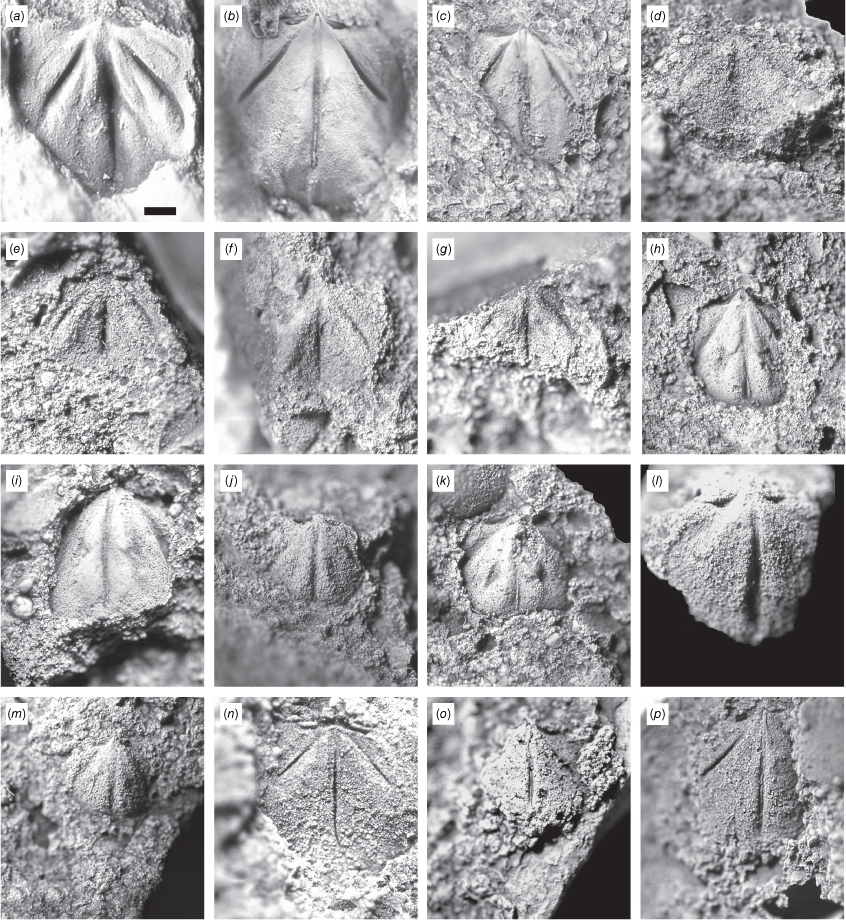
Boucotia australis. a, b from Broadford Formation, loc. PL6710, Williamson’s Creek. (a) NMV P321654, ventral valve internal mould. (b) NMV P321655, ventral valve internal mould. c–e from the Barrier Sandstone Member, Broadford Formation, loc. PL6714, Sheoak Hill. (c) NMV P321658, dorsal valve internal mould. (d) NMV P321659, ventral valve internal mould. (e) NMV P321663, dorsal valve internal mould. (f) NMV P321664, ventral valve internal mould from the Barrier Sandstone Member, Broadford Formation, loc. PL6765, Ghin Ghin. (g–j) From the Barrier Sandstone Member, Broadford Formation, loc. PL6769, Quarry Hill. (g) NMV P321666, dorsal valve internal mould. (h) NMV P321667, ventral valve internal mould. (i) NMV P321668, ventral valve internal mould. (j) NMV P321669, ventral valve internal mould. (k) NMV P321672, ventral valve internal mould from Norton Gully Sandstone, loc. PL6772, Goulburn Valley Highway. (l) NMV P321686, ventral valve internal mould from sandstone member of Humevale Siltstone, loc. PL229, Collins Quarry, Kinglake. Scale bar in a is 1 mm, applies to all.
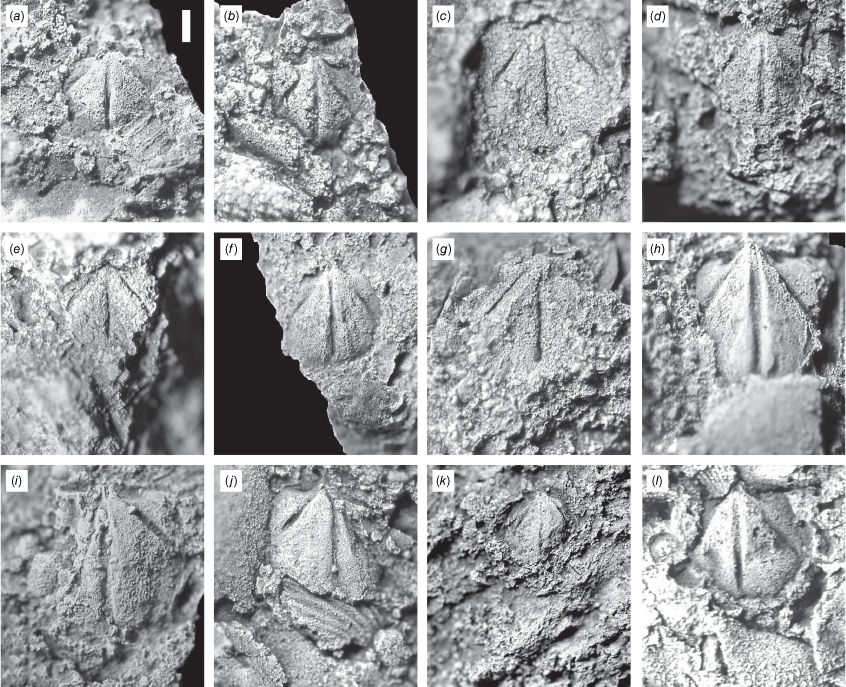
B. australis in the basal bed of the Barrier Sandstone Member, near the core of the area mapped by Couper (1965) and Garratt (1978) as the oldest units in the Yea area, shows that much of the ‘Yea Formation’ is of Lochkovian age and is consistent with the identification as Broadford Formation.
Boucotia loyolensis (Gill, 1951)
pars Leptaena rhomboidalis (Wilckens): Chapman 1913, pp. 103–104, pl. 10, figs 6, 7 [i.e. specimens from Loyola only].
Notanoplia loyolensis Gill 1951, pp. 63–64, pl. 3, figs 1–4. – Couper 1965, p. 7, table 1.
Boucotia loyolensis (Gill); Gill, 1969, p. 1230, pl. 144, figs 19–21. – Garratt 1980a, pp. 35–36, pl. 8, figs 34–41. – Garratt 1983, p. 88, fig. 5. – Earp 2012, p. 137, fig. 1F.
For synonymy to 1980 see Garratt (1980a).
Holotype NMV P12403 from siltstone of the Norton Gully Sandstone at Loyola, Victoria. Late or latest Pragian (Sandford in VandenBerg et al. 2006, p. 385) to earliest Emsian (Alberti 1997, p. 119).
NMV P321626, ventral valve internal mould from Couper’s loc. 60, Killingworth Road; massive lensoidal mass-flow diamictite of the Norton Gully Sandstone. Also examined were unregistered specimens in the Museums Victoria stratigraphic collection, collected by the Harris and Thomas (1941) party, from their loc. 12, Killingworth Road.
Boucotia loyolensis from Norton Gully Sandstone, loc. 60 of Couper (1965). NMV P321626, ventral valve internal mould. Scale bar 1 mm.
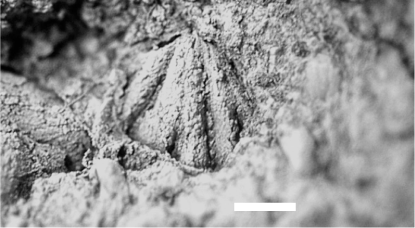
B. loyolensis is less common than B. australis (Garratt 1980a). Occasionally it is found without B. australis, e.g. in some Norton Gully Sandstone turbidites at the headwaters of Cable’s Creek (‘Cales’ Creek in Garratt 1980a, p. 36), and in the same facies outcropping east of Tait’s Lane, Cathkin. On the other hand, B. australis often occurs alone in undoubted Norton Gully Sandstone, possibly because it is for some reason more resistant than B. loyolensis to fragmentation during turbidite transport.
Garratt (1980a, p. 36) recorded a specimen from loc. 10 of Harris and Thomas (1941), the same locality also containing Uncinatograptus thomasi (Garratt 1983, p. 81). Although both Garratt’s references state the locality is at ‘Yea’, it is actually at Molesworth (Fig. 2).
Notanoplia philipi Garratt, 1980
Notanoplia philipi Garratt 1980a, pp. 27–29, pl. 6, figs 27–32, pl. 7, figs 1–10, 17, 33.
Holotype NMV P128478 from the Boola Siltstone, late Lochkovian–early Pragian (Talent et al. 2001, p. 152). Paratypes NMV P134920, P137898, P137899 from the same locality as the holotype and the types of Lissatrypa lenticulata (Philip 1962, loc 43).
This specimen is closely comparable to those figured by Garratt (1980a, e.g. pl. 6, fig. 27) from the type locality. Garratt (1980b, p. 160) also recorded specimens from ‘loc. G15’ (loc. PL1815, Rowville), Humevale Siltstone, B. janaea biozone (Garratt 1983, fig. 5), and ‘loc. G87’ (loc. PL1887, Mooroolbark), Humevale Siltstone, B. loyolensis biozone (Garratt 1983, fig. 5), Pragian (Sandford 2003, text fig. 2).
Septaparmella Su, 1976
S. sinica Su (1976), from the Lochkovian–Pragian of north-eastern China (Talent et al. 2001, p. 96).
(In part from Su 1976, p. 185 and Talent et al. 2001, p. 177.) Small, thin-walled shells with a shield-shaped outline, convex in lateral profile. Ventral and dorsal valves with obscure radial costation and growth lines. Hingeline straight, shorter than the maximum shell width. Cardinal angles obtuse. Ventral interarea of medium height, triangular; dorsal interarea linear; delthyrium and notothyrium open, triangular. Ventral interior with a strong median septum which is triangular in cross-section. Dorsal interior with a median septum, and with strong socket ridges parallel to the hingeline. No side septa in either valve.
Talent et al. (2001) indicated that the Victorian species Notoparmella plentiensis Garratt is best placed in this genus, and emended Su’s generic diagnosis, but did not actually use the new species combination. S. plentiensis, like S. sinica, has a strong triangular ventral median septum, not the weak ‘pair of closely spaced subparallel ridges’ in the type species of Notoparmella (Johnson 1973, p. 1627).
Septaparmella plentiensis (Garratt) comb. nov.
Notoparmella plentiensis Garratt 1980a, pp. 22–24, pl. 5, fig. 1–27, pl. 6, figs 1–3. – Garratt 1983, p. 87, figs 5, 6. – Talent et al. 2001, pp. 152, 159, 177.
?Notanoplia mitchelli Wright 1981, figs 1f, g only (fide Talent et al. 2001, p. 159).
Holotype NMV P49695. Garratt (1980a) also specified a number of paratypes. The types are all from GSV loc. A17, Humevale Siltstone, Upper Plenty. The nearest datable locality is below this, at loc. PL1623 (GSV loc. F10) which contains Bohemograptus bohemicus bohemicus showing a tendency to B. bohemicus tenuis and thus possibly not of the lowest Ludlow nilssoni biozone (Rickards and Sandford 1998, p. 754). The age of the A17 locality is therefore not older than Ludlow and not younger than Pridoli.
Dorsal valve internal mould NMV P321673, ventral valve internal moulds P321674 and P321675, all from the Ready Money Siltstone Member at PL6775, Murrindindi. Dorsal valve internal moulds NMV P321676, P321678, P321679 and ventral valve internal mould P321677, all from gritty sandstone float (Providence Hill Sandstone Member) on the ridgeline above (but stratigraphically below) PL6775.
Septaparmella plentiensis from Broadford Formation, Murrindindi. (a–c) Found in place, Ready Money Siltstone Member, loc. PL6775. (a) NMV P321673, dorsal valve internal mould. (b) NMV P321674, ventral valve natural internal cast. (c) NMV P321675, dorsal valve internal mould. (d–f) Found in float presumably from the Providence Hill Sandstone Member, ridgeline above loc. PL6775. (d) NMV P321676, dorsal valve internal mould. (e) NMV P321677, ventral valve internal mould. (f) NMV P321678, dorsal valve internal mould. (g) NMV P321679, dorsal valve internal mould. Scale bar in a is 1 mm, applies to all.
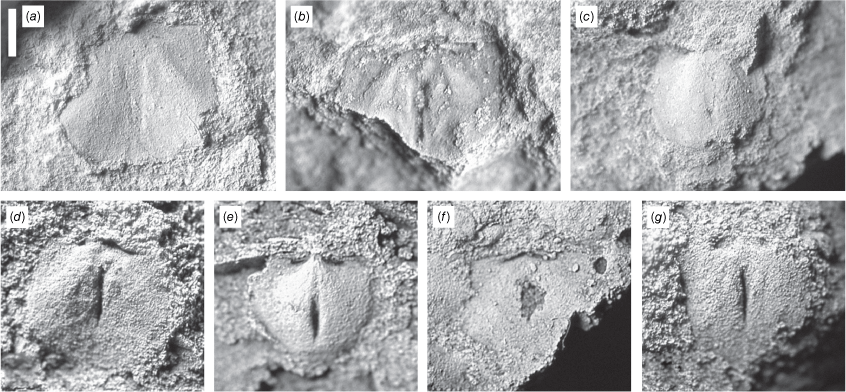
The new material was referred to in a previous paper (Earp 2007, p. 291) as being ‘similar to … but probably not identical with’ S. plentiensis. This was based on the highly compressed specimens from the Ready Money Siltstone Member, which seemed not to display the bifurcation of the ventral median septum near the anterior margin (Garratt 1980a, p. 24). Closer examination has shown that the bifurcation is present, although almost obliterated by compression and metamorphism.
In its type area in the Merriang Syncline of Upper Plenty, the species commonly occurs with the Silurian brachiopod Macropleura densilineata, but this latter species is not seen elsewhere in Victoria (Garratt 1980b, p. 307).
Specimens from loc. W78, near Glenburn (Garratt 1980b, p. 596 as loc. T106; Garratt 1983, p. 84, fig. 4 as T106) were not illustrated by Garratt (1980a) but were deposited with Museums Victoria and were examined during this study. The matrix is a metamorphosed siltstone and the specimens are not well preserved, but the identification as S. plentiensis is likely correct. Garratt (1980a) considered W78 may be as young as early Lochkovian, but there are no other fossils and the area is so poorly exposed that no correlation with dateable units is possible.
Garratt (1980b, p. 33) stated that ‘shell fragments, including Howellella sp. and Notoparmella plentiensis’ occurred in his Rice’s Hill Sandstone Member; this was later revised to ‘fragments of shelly fossils including notanopliid brachiopods and Howellella sp.’ (Garratt et al. 1983, p. 59) and in his taxonomic work (Garratt 1980a) no specimens from that unit were cited nor was the occurrence in that unit mentioned.
Garratt and Wright (1988) considered the plentiensis zone to extend from the base of the Ludfordian through the Pridoli. On the other hand, Wright’s (1981) New South Wales material may be from the earliest Lochkovian (Talent et al. 2001; Percival and Zhen 2017, p. 27). A mention of ‘Notoparmella’ from ‘probably Pridolian‒Lochkovian sandstones’ in New Zealand (Wright 1990, p. 51) may refer to S. plentiensis but was not accompanied by any further identifying information.
Sandford (2002) extended the plentiensis zone to the lower Ludlow on the basis of its reported occurrence in the Mt. Phillipa Sandstone Member (Garratt 1980b, fig. 67, under loc. W57; Garratt and Wright 1988 as ‘loc. 57’). However, the locality appears to be above the Mt. Phillipa Member at or even above the stratigraphic horizon of loc. A17 (Garratt 1983, figs 3, 6). A more exact determination of the stratigraphic position would be desirable, as well as critical examination of the specimens. Poor preservation may possibly lead to confusion with Nucleospira, a brachiopod of very roughly similar size and shape with a prominent median septum, which also occurs at that locality, the only place where both have been recorded together (Garratt 1980b, fig. 67).
Maoristrophia Allan, 1947
Maoristrophia neozelanica Allan (1947), from the Bolitho Mudstone (Bradshaw and Hegan 1983) at Lankey Creek, Reefton, South Island, New Zealand; approximately early Emsian (Talent et al. 2001, p. 165).
Talent et al. (2001, pp. 151, 155, 163) recognised the species M. keblei Gill (1952) from the Lochkovian to Pragian of New South Wales, Victoria, and Tasmania. The species M. banksi Gill (1952) is also recognised as occurring in Victoria (e.g. Talent et al. 2001, p. 151, Warne et al. 2003, p. 619). It is not clear whether a statement that the two species are synonymous (Talent et al. 2001, p. 155) applies only to the New South Wales specimens or more widely. Arguably there are sufficient differences between the two (Gill 1952; Garratt 1980b, p. 173), so they are retained here as separate species. The type of M. banksi is from the Lochkovian of Tasmania.
Apart from the Australasian species, the following are recognised by Talent et al. (2001): M. medinensis (Ushatinskaya) (=M. praemedinensis Kaplun) and M. carinata (Borisyak) from the early Lochkovian of Kazakhstan (Talent et al. 2001, pp. 60–61); M. kailensis Shishkina (=M. grandis Alekseeva) from the Pragian–Emsian of Mongolia, the Russian Far East and neighbouring regions of China (Talent et al. 2001, pp. 82–83, 90–94).
The genus was brought into the discussion on the age of the Lower Plant Assemblage by Garratt (1978), who originally named only M. banksi and the bivalve Neklania as shelly fossils supporting a Ludlow age.
It was pointed out by Edwards et al. (1979, p. 322) that Neklania is known only from the Early Devonian and that M. banksi ‘has been reported only from the Lower Devonian of Australasia’.
In reply, Garratt (1981) gave a previously unpublished record of M. banksi in the Clonbinane Sandstone (latest Ludlow: Sandford 2005a) and stated that it was ‘unfortunate’ that Edwards et al. (1979) had relied on ‘the published lower stratigraphic range … of an endemic rare genus such as Maoristrophia’. He also cited ‘an undescribed similar form from the Late Wenlockian of Canberra’.
This form was later published as M. papilio by Strusz (1983, p. 163), whose introductory paragraph was aimed at supporting Garratt’s age of the Lower Plant Assemblage, and who specifically stated ‘that the genus appeared prior to the Devonian is confirmed’. This is irrelevant. The original claim was not that the genus supported a Ludlow age, but that the species M. banksi did so (Garratt 1978). Furthermore, Talent (in Gratsianova et al. 1988) reassigned M. papilio to a new genus Desistrophia, of which it is the type species, and it continues to be maintained as a separate genus (e.g. Strusz 2010, fig. 3F–H).
It would appear, from the detailed generic descriptions in Cocks and Rong (2000), remarks by Talent et al. (2000, pp. 182–184), and the faunal lists in Talent et al. (2001), that previous assignments (Talent in Gratsianova et al. 1988) from Early Devonian Maoristrophia to Eomaoristrophia (type species E. kobdensis is Wenlock–Ludlow) have not been sustained.
Garratt (1981) also cited ‘Maoristrophia sp. and Monograptus vulgaris [Ludlow] from the top of the Austral Creek Siltstone of Tasmania (Talent and Banks 1967, p. 158)’. The graptolite has since been redetermined as Pristiograptus cf. fragmentalis (Bouček), of Pridoli age (Rickards and Banks 1992). Like other supposed Silurian occurrences of Maoristrophia recorded by Garratt (1983), this is identified by name only, with no description.
It remains true, therefore, that all published well-documented records of Maoristrophia in general and M. banksi in particular are from the Early Devonian (Gill 1952, from the Bell Shale of Tasmania; Talent 1964, from the highest unit of the Mt Ida Formation, Victoria; Savage 1974, from the Maradana Shale of New South Wales). This is not to rule out Silurian occurrences, but the citation of name-only mentions in support of an argument of major significance is far from persuasive. A critical evaluation of Maoristrophia from the Silurian Clonbinane Sandstone would be highly desirable.
The position remains that at the present time, Garratt’s records of M. banksi (from PL1487, Ghin Ghin; Garratt 1980b, pl. 6, fig. 16; not PL1486 Limestone Road as stated by Tims and Chambers 1984, p. 267) and Neklania (from PL1486, Limestone Road) support an Early Devonian rather than Silurian age for the Lower Plant Assemblage (Edwards et al. 1979).
Maoristrophia keblei Gill, 1952
Maoristrophia keblei Gill 1952, pp. 182–183, pl. 36, figs 9–11. – Gill et al. 1966, pp. 358–360, pl. 39, figs 7–15. – Talent et al. 2001, pp. 151, 155. – Warne et al. 2003, p. 619, fig. 22.6l
Eomaoristrophia keblei (Gill) – Gratsianova et al. 1988, p. 95, text fig. b.
Holotype ventral valve NMV P14612 (internal mould) and P14613 (external counterpart); paratype dorsal valve P14614; both from loc. PL1801, Lilydale, Victoria.
NMV P321671, internal and external moulds of a dorsal valve from PL6769, Quarry Hill, Ghin Ghin. NMV P321680, internal and external moulds of a ventral valve from PL6779, a Norton Gully Sandstone outcrop near Pig and Whistle, Molesworth, east of Yea; NMV P321687, external mould of a dorsal valve, also from PL6779.
Maoristrophia keblei. (a, b) NMV P321671, dorsal valve internal and external moulds, Barrier Sandstone Member, Broadford Formation, loc. PL6769, Quarry Hill. (c) NMV P321680, ventral valve internal mould, Norton Gully Sandstone, loc. PL6779, Molesworth. (d) NMV P321687, dorsal valve external mould, Norton Gully Sandstone, loc. PL6779, Molesworth. All scale bars 10 mm.

The type locality lies within the B. loyolensis biozone (Garratt 1983, fig. 5 as loc. G1), and at a level which contains Pragian trilobites (Sandford 2003, text fig. 2). Gill et al. (1966) also recorded M. keblei from PL1803 (lowest Boucotia australis assemblage biozone, Lochkovian).
The specimens reported here from the Norton Gully Sandstone are unconfirmed without a dorsal valve, but the species has been previously recorded from the same unit at Loyola (Garratt 1983, p. 88).
Plectodonta (Plectodonta) bipartita (Chapman, 1913)
Chonetes bipartita Chapman 1913, p. 104, pl. 10, figs 8–10.
Stropheodonta bipartita (Chapman) Gill 1942, p. 41, pl. 5, figs 7, 9, pl. 6, fig. 10.
Plectodonta bipartita (Chapman) Gill 1948, pp. 13–14. – Gill 1950, p. 249, pl. 1, figs 21–23. – Philip 1962, pp. 204–205, pl. 31, figs 18, 19. – Talent 1963, p. 67, pl. 30, figs 11–24, pl. 40, figs 19–22. – Williams 1964, p. 282, table 1. – Savage 1974, pp. 25–27, pl. 2, fig. 20–31 – Garratt 1983, pp. 87–89, figs 5–7. – Jell 1992, p. 10. – Garratt in Sandford 2002, p. 6.
Plectodonta (Plectodonta) bipartita (Chapman) – Strusz 2003, pp. 21–25, figs 14A–E, 15A–J. – Strusz 2010, fig. 3C′–3E′. – Earp 2015, p. 13, fig. 6A–D.
For a more detailed synonymy see Strusz (2003).
Chapman (1913) designated two ‘cotypes’ which unfortunately are from widely separated localities and possibly different stratigraphic levels. NMV P12405 (Chapman 1913, pl. 10, fig. 10) was designated as lectotype by Strusz (2003, p. 22). NMV P12406, from the same locality was designated a paratype by Chapman. The other ‘cotype’, which must be regarded as a syntype only, is NMV P12404 from loc. PL1820, Humevale Siltstone, B. janaea biozone, Lochkovian (Garratt 1983, fig. 5 as loc. G20). Unfortunately, the locality given for the lectotype and paratype, ‘Simmonds’ Bridge Hut’ (PL1875), is not known today, but it may have been in Humevale Siltstone (Earp 2007).
NMV P321660, ventral valve internal mould; NMV P321661, ventral valve external mould; NMV P321662, dorsal valve internal mould; all from loc. PL6714, Barrier Sandstone Member, Sheoak Hill.
Plectodonta (Plectodonta) bipartita from the Barrier Sandstone Member, Broadford Formation loc. PL6714, Sheoak Hill. (a) NMV P321660, ventral valve internal mould. (b) NMV P321661, dorsal valve external mould. (c) NMV P321662, dorsal valve, internal mould. Scale bar in A is 5 mm, applies to all.
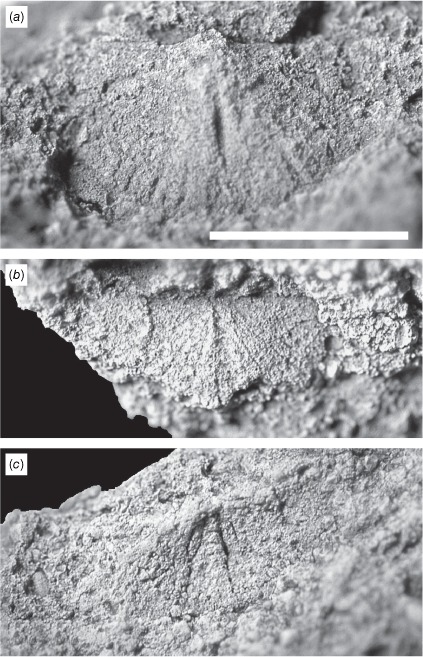
These specimens occur with Boucotia australis, an assemblage often found in the Broadford Formation. The species has been reported from a range of ages from Late Silurian to Pragian (see discussion in Earp 2015).
Tyersella Philip, 1962
Considered a subgenus of Isorthis by Walmsley and Boucot (1975), the latest Treatise volumes have restored Tyersella to generic rank (Williams et al. 2000, p. 789).
Tyersella typica Philip, 1962
Tyersella typica Philip 1962, pp. 198–200, pl. 30, figs 12–19; text fig. 10.
Isorthis (Tyersella) typica (Philip) Walmsley and Boucot 1975, p. 58. – Talent et al. 2001, pp. 152–153.
Holotype NMV P127684, internal and externals moulds of a dorsal valve, by original designation. Five other specimens from the same locality were illustrated by Philip and are here designated paratypes: NMV P127695, P127696, P127723, P127724, P 127725. These are all from Philip’s loc. 36 in the Boola Formation, Tyers. This is in conglomerate underlying an outcrop of Coopers Creek Limestone containing Eolinguipolygnathus dehiscens (loc. 12 of Mawson and Talent 1994, p. 39), and elsewhere the limestone contains Eognathodus ‘sulcatus’ (Mawson and Talent 1994, p. 42) indicating a position within or slightly above the Pragian Eognathodus irregularis zone (Murphy 2005, p. 189).
Dorsal valves NMV P310902, P310903 and ventral valves P310904, P310905, all from loc. PL6700, Murrindindi Road.
Tyersella typica from loc. PL6700, Murrindindi Road. (a) Two ventral valve internal moulds, NMV P310904 (left) and P310905 (right). (b) Ventral valve internal mould P310904 in lateral profile. (c, d) Dorsal valve NMV P310902, latex of internal mould, and internal mould. (e) Dorsal valve internal mould NMV P310903. All scale bars 5 mm.
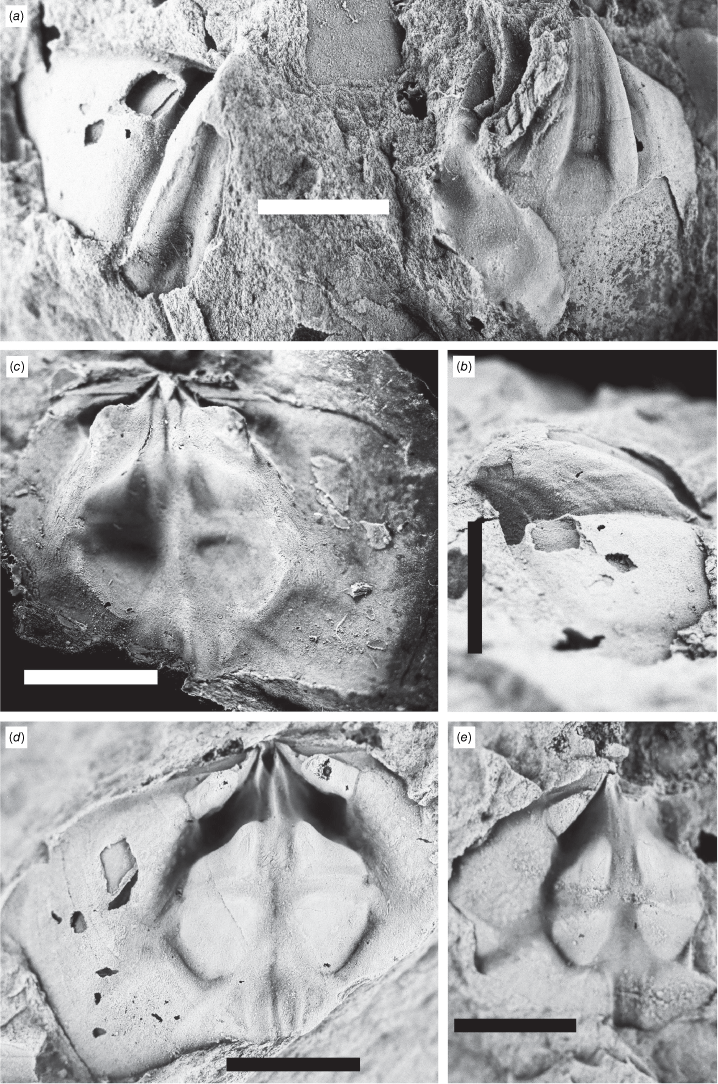
This is the first definite record of T. typica from central Victoria. These specimens have identical internal morphology to those figured by Philip (1962). Note especially the ‘faceted’ diductor ridge in Fig. 19a, the same as in Philip’s pl. 30, fig. 19.
Talent (1964) considered that some of his isorthid specimens from the Mt. Ida Formation might be referrable to Tyersella, and Walmsley and Boucot (1975) referred them to T. typica. The dorsal valve illustrated by Talent (1964, pl. 10, fig. 2) could not be located but very similar specimens collected by John Neil and by Noel Schleiger were examined in this study. The dorsal muscle field of these specimens is oval (and not deeply impressed) compared with the markedly pentagonal field of T. typica so they are not here considered to be conspecific.
Garratt (1983, p. 88) stated T. typica occurred in Boucotia loyolensis biozone localities at Yea and adjacent areas. Relevant specimens could not be located in Museums Victoria in this study, and given the doubt about the Mt. Ida Formation species, the reports must be regarded as unconfirmed.
Howellella (Howellella) sp.
NMV P321657, fragment of a dorsal valve, internal and external moulds; a similar dorsal valve is on the same slab as NMV P321651. Both from loc. PL6710, Williamson’s Creek.
(Of dorsal valves only.) Valves convex but relatively flat, with medial fold and at least three pairs of lateral plications, the outside ones being very obscure. Micro-ornament of lamellae with rows of minute spines. Interarea low. Cardinal process is a ctenophoridium of six or seven lamellae at the posterior end of the notothyrium. Crural plates fused to long socket ridges which are parallel to the hinge line. Long median myophragm.
This may or may not be the same species as Howellella sp. A of Earp (2015); although of similar size, it is here left indeterminate. However, the micro-ornament and cardinal process confirm the generic assignment. Similar small spiriferids occur at loc. PL6705, but are too poorly preserved to be definitely assigned to Howellella, and the ventral valves have much shorter dental lamellae than those figured by Garratt (1980b) and Earp (2015, fig. 6E). Small spiriferids also occur at loc. PL6715, but the preservation is even worse because of the much larger grain size of the matrix.
Lissatrypa cf. lenticulata Philip, 1962
Lissatrypa lenticulata Philip 1962, pp. 220–221, text fig. 16, pl. 34, figs 4, 17–21. – Williams 1964, p. 282, table 1. – Savage 1974, pp. 38–29, text fig. 12, pl. 10, figs 16–30. – Garratt 1983, pp. 86, 93, figs 5–7. – Jell 1992, p. 10.
Lissatrypa cf. lenticulata Philip and Lissatrypa spp. – Talent 1964, p. 35, pl. 8, figs 1, 2, 4, 6, 8–10.
Australina? lenticulata (Philip) – Lenz and Johnson 1985, p. 82, pl. 8, figs 1–12. – Talent et al. 2001, pp. 150, 153, 155, 158. – Earp 2015, p. 14, fig. 7.
Meifodia lenticulata (Philip) – Strusz 2007, pp. 332–335.
Holotype NMV P127463 from the Boola Siltstone, late Lochkovian–early Pragian (Talent et al. 2001, p. 152). Philip’s figured specimens NMV P127464, P127465, P127460 and P127688, and an additional specimen P127689, all from the same locality as the holotype and the types of Notanoplia philipi (Philip 1962, loc 43), should be designated as paratypes.
NMV P321630, small ventral valve internal mould from PL6705, Killingworth West Road, Barrier Sandstone Member in the Broadford Formation.
The relatively small size of the specimen is probably attributable to sorting during turbidite deposition. Large shells of any species are lacking at this locality.
Strusz (2007) discussed the various possible generic assignments of Australian Siluro-Devonian species. His arguments against Australina are persuasive, but those supporting Meifodia versus Lissatrypa are much less so, and until specimens can be found which allow examination of the spiralia and jugal structures it is considered better at present to revert to the original genus.
Decacrinus sp.
Decacrinus sp. Earp 2015, p. 14, fig. 8
Small- to medium-sized pentagonal columnals, diameter 3.5–6 mm. Lumen not seen. Areola 10-lobed, alternating long acute lobes at the angles of the pentagon almost reaching the edge with short rounded lobes at the centre of each side reaching only halfway to the edge. Fine culmina and crenellae emanate from the sides of all lobes and cover the remainder of the surface; those from near the ends of each lobe proceed radially and reach the edge of the columnal at nearly right angles. Lobes coalesce at their bases.
This type of columnal occurs along the line of outcrop of the Barrier Sandstone Member from PL6705 south to PL6711 near the Yea River, a distance of 3.7 km, and with Boucotia australis in the Broadford Formation near Broadford (Earp 2015). It is therefore an indicator of the B. australis biozone.
Conclusions
This study confirms by lithology and palaeontology that the oldest sediments in the Yea area, along the axis of the Yea Anticline, are correctly assigned to the Broadford Formation as mapped by Welch et al. (2011). The depositional environment was a submarine fan.
In the lower horizons of this formation at Yea, conglomerates are most common to the north and west. The Broadford Formation then fines upward and to the south and east. A source in the Heathcote area is inferred.
In addition to the lithological variation, the geology is complicated by asymmetry about the Yea Anticline due to post-depositional causes. The Flat Lead metamorphic zone (?Middle Devonian) has no counterpart on the east side of the Anticline. Between the Goulburn River and Yea township, the west side of the Anticline is severely eroded by the Yea River. South of Yea township it is the east side which is eroded. These factors affect the availability of fossil localities.
The oldest brachiopod biozone identified at Yea is that of Septaparmella plentiensis (certainly Pridoli, upper and lower boundaries uncertain) at a single locality. The same horizons are present elsewhere along the Yea Anticline but no other finds were made. This is attributed to poor exposures and the inherent lithological variability of the depositional environment.
The next higher biozone identified is that of Boucotia australis (Lochkovian, but may extend to early Pragian). A number of localities contain the nominate species and associated characteristic fossils. The lowest horizon of this biozone is the Barrier Sandstone Member. The major part of the Broadford Formation at Yea is above that horizon and is therefore Lochkovian or younger.
The higher B. loyolensis biozone (Pragian–Emsian), coeval with the Uncinatograptus thomasi graptolite biozone, has long been known to occur at Yea in the Walhalla Group (Couper 1965). Additional localities have been identified in this study, including ones which correlate with the Woori Yallock Formation much further south.
The question of the controversial age of the Lower Plant Assemblage is only partially answered in this study. The localities of Couper (1965) and Garratt (1978) west of the Yea Anticline, and claimed to be Silurian, are shown to belong to the B. loyolensis biozone and are therefore Pragian–Emsian. No conclusion can be reached for the other localities including those claimed to contain Gorstian graptolites (Garratt 1978; Garratt and Rickards 1984). The distance between these and the nearest notanopliid localities are too great to justify estimation by extrapolation.
On the other hand, the ‘undescribed flora’ suggested to be of Wenlock age (Garratt et al. 1984, table 1) on the basis of just such a lithological extrapolation, has been shown in this study to be situated within the B. australis biozone (Lochkovian).
Data availability
The data that support this study are available in the article and in the linked notes cited in the article as Earp (2023), i.e. in ResearchGate repository at DOI 10.13140/RG.2.2.16869.58085.
Acknowledgements
This study would not have been possible without the cooperation of a large number of landowners in the Yea area. I particularly wish to thank Peter McLeish, Bill and Louise Wilson, Alan Cassells, Adrian Sier, Campbell McLeish, Ken Thompson, Stu McCracken, Nattie and the late Eric Jowett, David Crockett, Jack Mahon, Bill Armstrong, Phillip Wisscher, and numerous others whose names I have regrettably forgotten. Melody Pepper assisted with the often arduous field work and extraction of the fossils. David Holloway, Fons VandenBerg, the late Noel Schleiger and the late Jack Douglas provided much advice and encouragement over the years. I also thank Bill Birch for his editorial assistance, and the anonymous reviewers for their helpful comments.
References
Afanasjeva GA (2012) Systematic position and composition of the superfamily Notanoplioidea Gill, 1969 (Brachiopoda, Articulata). Paleontological Journal 46, 1309-1324.
| Crossref | Google Scholar |
Alberti GKB (1988) Stratigraphische Untergliederung einiger Lochkovium/Pragium-Grenzprofile (Unter-Devon) in NW-Marroko, Oberfranken und Victoria (SE-Australien) auf Grund von Dacryoconariden und Conodonten. Senckenbergiana Lethaea 68, 479-493 [In German].
| Google Scholar |
Alberti GKB (1997) Devonian planktonic Tentaculids I. Homoctenida Bouček und Dacryoconarida Fisher 1962 from the Lower to Upper Devonian. Palaeontographica Abteilung A A244, 85-142.
| Crossref | Google Scholar |
Allan RS (1947) A revision of the brachiopoda of the Lower Devonian strata of Reefton, New Zealand. Journal of Paleontology 21, 436-452.
| Google Scholar |
Bradshaw MA, Hegan BD (1983) Stratigraphy and structure of the Devonian Rocks of Inangahua Outlier, Reefton, New Zealand. New Zealand Journal of Geology and Geophysics 26, 325-344.
| Crossref | Google Scholar |
Brock GA (2003) Lochkovian (Early Devonian) Brachiopods from the Garra Limestone at Eurimbla, New South Wales, Australia. Part 2: Rhynchonellida, Atrypida, Athyridida, Spiriferida. Palaeontographica Abteilung A A270, 49-94.
| Crossref | Google Scholar |
Camilleri TTA, Warne MT (2015) Preservation and assemblage characteristics of some ornate Lower Devonian Ostracoda from the Humevale Siltstone and Woori Yallock Formation, southeastern Australia. Alcheringa: An Australasian Journal of Palaeontology 39, 71-91.
| Crossref | Google Scholar |
Chapman F (1913) New or little-known Victorian fossils in the National Museum. Part xvi. Some Silurian Brachiopoda. Proceedings of the Royal Society of Victoria 26, 99-113.
| Google Scholar |
Couper J (1965) Late Silurian to Early Devonian stratigraphy of the Yea-Molesworth District, Victoria. Proceedings of the Royal Society of Victoria 79, 1-9.
| Google Scholar |
Earp C (2007) Contributions to the palaeontology of the Yea area, central Victoria: I. the fossil coral Pleurodictyum megastoma. The Victorian Naturalist 124, 288-295.
| Google Scholar |
Earp C (2012) Boucotia (Brachiopoda: Notanopliidae) from Montys Hut Formation (Early Devonian), central Victoria. Proceedings of the Royal Society of Victoria 124, 136-138.
| Google Scholar |
Earp C (2013) ‘The Yea Goldfields’. (Auct.: Ashburton) 110 pp. Available at http://www.digitalprintaustralia.com/bookstore/non-fiction/historical/the-yea-goldfields.html
Earp C (2015) Early Devonian fossils from the Broadford Formation, central Victoria. Proceedings of the Royal Society of Victoria 127(2), 7-16.
| Crossref | Google Scholar |
Earp C (2023) A review of previous geological investigations in the Yea district, central Victoria, Australia. 10.13140/RG.2.2.16869.58085
Edwards D, Bassett MG, Rogerson ECW (1979) The earliest vascular land plants: continuing the search for proof. Lethaia 12, 313-324.
| Crossref | Google Scholar |
Edwards JE, Olshina A, Slater KR (1997) Nagambie and part of Yea 1:100 000 map geological report. Geological Survey of Victoria Report 109, 1-142.
| Google Scholar |
Garratt MJ (1978) New evidence for a Silurian (Ludlow) age for the earliest Baragwanathia flora. Alcheringa: An Australasian Journal of Palaeontology 2, 217-224.
| Crossref | Google Scholar |
Garratt MJ (1980a) Siluro-Devonian Notanopliidae (Brachiopoda). Memoirs of the National Museum of Victoria 41, 15-41.
| Google Scholar |
Garratt MJ (1981) The earliest vascular land plants: comment on the age of the oldest Baragwanathia flora. Lethaia 14, 8.
| Crossref | Google Scholar |
Garratt MJ (1983) Silurian and Devonian biostratigraphy of the Melbourne Trough, Victoria. Proceedings of the Royal Society of Victoria 95, 77-98.
| Google Scholar |
Garratt MJ, Rickards RB (1984) Graptolite biostratigraphy of early land plants from Victoria, Australia. Proceedings of the Yorkshire Geological Society 44, 377-384.
| Google Scholar |
Garratt MJ, Rickards RB (1987) Pridoli (Silurian) graptolites in association with Baragwanathia (Lycophytina). Bulletin of the Geological Society of Denmark 35, 135-139.
| Google Scholar |
Garratt MJ, Holloway DJ, Neil JV (1983) Excursion to Heathcote, Yea and Kinglake West. Nomen Nudum 2, 53-61.
| Google Scholar |
Garratt MJ, Tims JD, Rickards RB, Chambers TC, Douglas JG (1984) The appearance of Baragwanathia (Lycophytina) in the Silurian. Journal of the Linnean Society (Botany) 89, 355-358.
| Crossref | Google Scholar |
Gill ED (1942) On the thickness and age of the type Yeringian strata, Lilydale, Victoria. Proceedings of the Royal Society of Victoria 54, 21-52.
| Google Scholar |
Gill ED (1948) A new trilobite from the Yeringian (Lower Devonian) rocks of Kinglake, Victoria. Proceedings of the Royal Society of Victoria 59, 8-19.
| Google Scholar |
Gill ED (1950) Preliminary account of the palaeontology and palaeoecology of the Eldon Group formations of the Zeehan area. Papers and Proceedings of the Royal Society of Tasmania for 1949 231-258.
| Google Scholar |
Gill ED (1951) Further studies in Chonetidae (Palaeozoic brachiopoda) from Victoria. Proceedings of the Royal Society of Victoria 63, 57-72.
| Google Scholar |
Gill ED (1952) Palaeogeography of the Australian–New Zealand region in Lower Devonian time. Transactions of the Royal Society of New Zealand 80, 171-185.
| Google Scholar |
Gill ED (1969) Notanopliidae, a new family of brachiopods from Australia. Journal of Paleontology 43, 1222-1231.
| Google Scholar |
Gill ED, Boucot AJ, Johnson JG (1966) The brachiopod genus Maoristrophia Allan (Lower Devonian, Strophomenacea) redescribed. Proceedings of the Royal Society of Victoria 79, 355-361.
| Google Scholar |
Gratsianova RT (1975) Elementy avstraliyskoy fauny sredi brakhiopod devona Altae Sayanskoy oblasti. Trudy Instituta Geologii i Geofiziki Sibirskogo Otdeleniya Akademii Nauk SSSR 259, 36-39 [In Russian].
| Google Scholar |
Gratsianova RT, Shishkina GR, Talent JA (1988) Reviziya nekotorykh taksonov Strofomenatsey (Brakhiopody). Trudy Instituta Geologii i Geofiziki Sibirskogo Otdeleniya Akademii Nauk SSSR 718, 89-100 [In Russian].
| Google Scholar |
Harris WJ, Thomas DE (1941) Notes on the Silurian rocks of the Yea district. Mining and Geological Journal 2, 302-304.
| Google Scholar |
Holloway DJ, Neil J (1982) Trilobites from the Mount Ida Formation (Late Silurian-Early Devonian), Victoria. Proceedings of the Royal Society of Victoria 94, 133-154.
| Google Scholar |
Jaeger H (1983) Unterdevonische Graptolithen aus Burma und zu vergleichende Formen. Jahrbuch der Geologischen Bundesanstalt (Wien) 126, 245-257 [In German].
| Google Scholar |
Jell PA (1992) Middendorp’s Quarry: a classic Australian Early Devonian fossil site. The Fossil Collector 38, 7-16.
| Google Scholar |
Jell PA (1999) Silurian and Devonian crinoids from central Victoria. Memoirs of the Queensland Museum 43, 1-114.
| Google Scholar |
Jell PA, Holloway DJ (1983) Devonian and ?Late Silurian palaeontology of the Winneke Reservoir site, Christmas Hills, Victoria. Proceedings of the Royal Society of Victoria 95, 1-21.
| Google Scholar |
Johnson JG (1973) Mid-Lochkovian brachiopods from the Windmill Limestone of Central Nevada. Journal of Paleontology 47, 1013-1030.
| Google Scholar |
Lenz AC, Johnson BD (1985) Brachiopods of the Garra Formation (Lower Devonian), Wellington area, New South Wales, Australia: Rhynchonellida, Spiriferida, Terebratulida. Palaeontographica A188, 71-104.
| Google Scholar |
Mawson R, Talent JA (1994) Age of an Early Devonian carbonate fan and isolated limestone clasts and megaclasts, east-central Victoria. Proceedings of the Royal Society of Victoria 106, 31-70.
| Google Scholar |
McKnight S, van Riel B, Cox B, Mecca R (1998) Exploring for disseminated gold at Yea, Victoria. Australian Institute of Geoscientists Bulletin 24, 99-106.
| Google Scholar |
McSweeney FR (2022) Early land plants of Victoria: new taxa, taxonomic revisions and insights into plant evolution. Doctoral thesis, RMIT University. Available at https://researchrepository.rmit.edu.au/esploro/outputs/9922109457201341
McSweeney FR, Shimeta J, Buckeridge JSJS (2021) Early land plants from the Lower Devonian of central Victoria, Australia, including a new species of Salopella. Memoirs of Museum Victoria 80, 193-205.
| Crossref | Google Scholar |
McSweeney FR, Shimeta J, Buckeridge JSJS (2022) Taungurungia gen. nov., from the Lower Devonian of Yea, central Victoria, Australia. Memoirs of Museum Victoria 81, 43-53.
| Crossref | Google Scholar |
Morand VJ (2010) Stratigraphic name changes in the Melbourne Zone, Seamless Geology Project. Geological Survey of Victoria Technical Record 2010(1), 1-10.
| Google Scholar |
Murphy MA (2005) Pragian conodont zonal classification in Nevada, western North America. Revista Española de Paleontología 20, 177-206.
| Google Scholar |
Mutti E (2019) Thin-bedded plumites: an overlooked deep-water deposit. Journal of Mediterranean Earth Sciences 11, 1-20.
| Google Scholar |
Mutti E, Ricci Lucchi F (1972) Le torbiditi del’Appennino Settentrionale: introduzione all’analisi di facies. Memorie Della Società Geologica Italiana 11, 161-19 [In Italian].
| Google Scholar |
Neil JV (1982) The Early Devonian fauna of the Mt. Ida Formation in the Heathcote District. The Victorian Naturalist 99, 195-201.
| Google Scholar |
Percival IG, Zhen YY (2017) Précis of Palaeozoic palaeontology in the Southern Tablelands region of New South Wales. Proceedings of the Linnean Society of New South Wales 139, 9-56.
| Google Scholar |
Philip GM (1962) The palaeontology and stratigraphy of the Siluro-Devonian sediments of the Tyers area, Gippsland, Victoria. Proceedings of the Royal Society of Victoria 75, 123-246.
| Google Scholar |
Phillips GN, Kisters AFM, Clemens JD (2022) The tabular Strathbogie batholith in central Victoria. Australian Journal of Earth Sciences 69, 776-800.
| Crossref | Google Scholar |
Plusquellec Y (2015) First record of the tabulate coral “Ligulodictyum” in the early Emsian of Victoria (Australia), with additional data on Australian Ligulodictyum sensu lato. Proceedings of the Royal Society of Victoria 127, 17-27.
| Crossref | Google Scholar |
Rickards RB (2000) The age of the earliest club mosses: the Silurian Baragwanathia flora in Victoria, Australia. Geological Magazine 137, 207-209.
| Crossref | Google Scholar |
Rickards RB, Banks MR (1979) An Early Devonian monograptid from the Mathinna Beds, Tasmania. Alcheringa: An Australasian Journal of Palaeontology 3, 307-311.
| Crossref | Google Scholar |
Rickards RB, Banks MR (1992) Two Monograptus species from the Pridoli of western Tasmania. Papers and Proceedings of the Royal Society of Tasmania 126, 9-11.
| Crossref | Google Scholar |
Rickards RB, Garratt MJ (1990) Přídolí graptolites from the Humevale Formation at Ghin Ghin and Cheviot, Victoria, Australia. Proceedings of the Yorkshire Geological Society 48, 41-46.
| Crossref | Google Scholar |
Rickards RB, Sandford AC (1998) Llandovery-Ludlow graptolites from central Victoria: new correlation perspectives of the major formations. Australian Journal of Earth Sciences 45, 743-763.
| Crossref | Google Scholar |
Sandford AC (2002) Systematics, biostratigraphy and palaeoenvironments of Echidnops, a new genus of phacopid trilobites from the Late Silurian–Early Devonian of south eastern Australia: Phacopidae of Victoria, part 1. Memoirs of the Association of Australian Palaeontologists 27, 1-31.
| Google Scholar |
Sandford AC (2003) A revision of Nephranomma Erben, 1952 (Trilobita: Phacopidae), with new species from the Lower Devonian of Victoria, Australia. Phacopidae of Victoria, part 2. Special papers in Palaeontology 70, 309-329.
| Google Scholar |
Sandford AC (2004) A revision of Lochkovella Chlupác, 1972 (Arthropoda: Trilobita) and a species from Lilydale and Tyers. Phacopidae of Victoria, Part 5. Proceedings of the Royal Society of Victoria 116, 207-220.
| Google Scholar |
Sandford AC (2005a) Homalonotid trilobites from the Silurian and Lower Devonian of south-eastern Australia and New Zealand (Arthropoda: Trilobita: Homalonotidae). Memoirs of Museum Victoria 62, 1-66.
| Google Scholar |
Sandford AC (2005b) Early Devonian phacopid trilobites from Seville, Australia. Phacopidae of Victoria, Part 4. Alcheringa: An Australasian Journal of Palaeontology 29, 1-28.
| Google Scholar |
Savage NM (1974) The brachiopods of the Lower Devonian Maradana Shale, New South Wales. Palaeontographica A146, 1-51.
| Google Scholar |
Schleiger NW (1964) Primary scalar bedding features of the Siluro-Devonian sediments of the Seymour district, Victoria. Journal of the Geological Society of Australia 11, 1-31.
| Crossref | Google Scholar |
Stow DAV, Shanmugam G (1980) Sequence of structures in fine-grained turbidites: Comparison of recent deep-sea and ancient flysch sediments. Sedimentary Geology 25, 23-42.
| Google Scholar |
Strusz DL (1983) Silurian Maoristrophia (Brachiopoda) from Canberra, Australia. Alcheringa: An Australasian Journal of Palaeontology 7, 163-168.
| Crossref | Google Scholar |
Strusz DL (2003) Late Silurian strophomenate brachiopods from Yass, New South Wales. Alcheringa: An Australasian Journal of Palaeontology 27, 1-35.
| Crossref | Google Scholar |
Strusz DL (2007) Silurian atrypide brachiopods from Yass, New South Wales. Alcheringa: An Australasian Journal of Palaeontology 31, 299-337.
| Crossref | Google Scholar |
Strusz DL (2010) Silurian brachiopod distribution in strata of the Canberra–Yass region, southeastern Australia. Memoirs of the Association of Australian Palaeontologists 39, 147-158.
| Google Scholar |
Talent JA (1963) The Devonian of the Mitchell and Wentworth Rivers. Memoirs of the Geological Survey of Victoria 24, 1-118.
| Google Scholar |
Talent JA (1964) The Silurian and Early Devonian fauna of the Heathcote district. Victoria. Memoirs of the Geological Survey of Victoria 26, 1-55.
| Google Scholar |
Talent JA, Mawson R, Aitchison JC, Becker RT, Bell KN, Bradshaw MA, Burrow CJ, Cook AG, Dargan GM, Douglas JG, Edgecombe GD, Feist M, Jones PJ, Long JA, Phillips-Ross JR, Pickett JW, Playford G, Rickards RB, Webby BD, Winchester-Seeto T, Wright AJ, Young GC, Zhen Y-Y (2000) Devonian palaeobiogeography of Australia and adjoining regions. Memoirs of the Association of Australasian Palaeontologists 23, 167-257.
| Google Scholar |
Talent JA, Gratsianova RT, Yolkin EA (2001) Latest Silurian (Pridoli) to middle Devonian (Givetian) of the Asio-Australia hemisphere: rationalization of brachiopod taxa and faunal lists; stratigraphic correlation chart. Courier Forschungsinstitut Senckenberg 236, 1-221.
| Google Scholar |
Tims JD, Chambers TC (1984) Rhyniophytina and Trimerophytina from the early land flora of Victoria, Australia. Palaeontology 27, 265-279.
| Google Scholar |
VandenBerg AHM (1975) Definitions and descriptions of Middle Ordovician to Middle Devonian rock units of the Warburton district, East Central Victoria. Geological Survey of Victoria Report 1975(6), 1-47.
| Google Scholar |
VandenBerg AHM, Cayley RA, Willman CE, Morand VJ, Seymon AR, Osborne CR, Taylor DH, Haydon SJ, McLean M, Quinn C, Jackson P, Sandford AC (2006) Walhalla–Woods Point–Tallangalook special map area geological report. Geological Survey of Victoria Report 127, 1-448.
| Google Scholar |
Walmsley VG, Boucot AJ (1975) The Phylogeny, Taxonomy and Biogeography of Silurian and Early to Mid Devonian Isorthinae (Brachiopoda). Palaeontographica A148, 34-108.
| Google Scholar |
Warne MT, Archbold NW, Bock PE, Darragh TA, Dettmann ME, Douglas JG, Gratsionova RT, Grover M, Holloway DJ, Holmes FC, Irwin RP, Jell PA, Long JA, Mawson R, Partridge AD, Pickett JW, Rich TH, Richardson JR, Simpson AJ, Talent JA, VandenBerg AHM (2003) Palaeontology: the biogeohistory of Victoria. In ‘Geology of Victoria. Vol. 23’. (Ed. W Birch) Geological Society of Australia Special Publication. pp. 605–652. (Geological Society of Australia: Melbourne)
Whitelaw OAL (1899) Geological survey of Parish of Ghin Ghin, County of Anglesey. Geological Survey of Victoria Progress Report 10, 34-35.
| Google Scholar |
Williams GE (1964) The geology of the Kinglake district, central Victoria. Proceedings of the Royal Society of Victoria 77, 273-327.
| Google Scholar |
Williams A, Carlson SJ, Brunton CHC, Holmer LE, Popov LE, Mergl M, Laurie JR, Bassett MG, Cocks LRM, Rong J-Y, Lazarev SS, Grant RE, Racheboeuf PR, Jin Y-G, Wardlaw BR, Harper DAT, Wright AD (2000) ‘Part H Brachiopoda (revised): Volumes 2 & 3, Linguliformea, Craniiformea, Rhynchonelliformea (part). Treatise on Invertebrate Paleontology.’ (Geological Society of America: Boulder, Colorado)
Wright AJ (1981) A new species of the brachiopod Notanoplia (Notanopliidae) from the Early Devonian of New South Wales. Records of the Australian Museum 33, 361-368.
| Crossref | Google Scholar |
Wright AJ (1990) Acastid trilobites from the Baton Formation (Early Devonian), New Zealand. New Zealand Journal of Geology and Geophysics 33, 49-53.
| Crossref | Google Scholar |


